26. BUSH (II) FUMBLES THE BALL

BUSH'S "DEMOCRATIC NATION-BUILDING" IN IRAQ
CONTENTS
 The idea of extending the "Bush The idea of extending the "Bush
Doctrine" to Saddam Hussein
 Bush decides that it is time for Saddam Bush decides that it is time for Saddam
Hussein to go – April 2003
 Things begin to bog down for the U.S. in Things begin to bog down for the U.S. in
Iraq
 2004: The situation in Iraq worsens 2004: The situation in Iraq worsens
 The 2004 presidential election The 2004 presidential election
 The Iraqi "quagmire" deepens The Iraqi "quagmire" deepens
(2005-2007)
 The 2007 "troop surge" The 2007 "troop surge"
The textual material on this webpage is drawn directly from my work
America – The Covenant Nation © 2021, Volume Two, pages 358-375.
THE IDEA OF EXTENDING THE "BUSH DOCTRINE" TO SADDAM
HUSSEIN |
|
Iraq and the Political Idealism of the "Neocons"
While the operation against al-Qaeda and the
Taliban had been building in Afghanistan (and Pakistan), Bush's
thoughts had never been far away from the perceived dangers coming from
Iraq and its dictator, Saddam Hussein. Indeed, one of the things that
marked the Bush presidency from its earliest days was the great
antipathy that the Bush White House had to Saddam Hussein, and its
determination to remove Saddam from power. Pushing this idea strongly
was the formidable neoconservative (or "neocon") team of Donald
Rumsfeld, Dick Cheney and Rumsfeld's Assistant Defense Secretary Paul
Wolfowitz. But Bush himself was also largely in line with this point of
view.
The neocons represented the old
tradition of Democratic Idealism, but a hawkish Idealism pushed by
all-out force rather than by the dovish Idealism promoted through
diplomatic appeasement. According to neo-con thinking, Saddam was a
dictator, an evil dictator, and he needed to go. With his disappearance
the Iraqis would have a wonderful opportunity to come to Democracy on
their own. And this Iraqi Democracy would stand in stark contrast to
the repressive Arab regimes that surrounded it. Iraq would become a
beacon of democracy offering hope to the rest of the Arab or Muslim
world. This fit well with Bush's concept of compassionate conservatism.
A strongly compassionate neoconservative stand on behalf of global
democracy was the very thing that supposedly dignified America. It had
long been (at least since the days of Woodrow Wilson a century earlier)
a key part of America's "compassion" with respect to the rest of
mankind. And thus the title "compassionate neoconservative" was a name
that these White House neo-cons intended to wear proudly.
With the events of 9/11, the neocon team
jumped at what they saw was the opportunity to connect Saddam with the
terrorist attack. In accordance with the new Bush Doctrine, any country
(except obviously Pakistan!) giving sanctuary or aiding in any way the
terrorists of 9/11 the Bush White House in its War or Terror was bound
to take down. Obviously (obvious to Bush and the neocons, anyway)
Saddam must have been guilty of at least such support ... placing
Saddam into the category of "terrorist enemy." The neocons felt that
they finally had in this anti-terrorist logic all the justification
they needed to go after Saddam.
Disagreements within the Cabinet
However, CIA chief George Tenet,
Secretary of State Colin Powell and National Security Advisor
Condoleeza Rice were very hesitant about going after Saddam. To their
understanding, the war in Afghanistan against al-Qaeda had to take
precedence over any attack on Iraq to remove Saddam; there was little
evidence that Saddam was connected with the 9/11 events; and failing to
be able to demonstrate such a connection, America would not likely get
the support from its allies that it would need to conduct effectively
an attack on Saddam in Iraq. And there was always the question of what
to do with Iraq if and when Saddam fell.
Cheney had quite conveniently forgotten
about his 1994 "quagmire" comment concerning Iraq, an earlier insight
resulting from his having served Bush Sr. as Secretary of Defense. But
Tenet, Powell and Rice still saw Iraq in that very same light. To go
crashing into Iraq to overthrow the Saddam regime and put in place
there a "democracy" was guaranteed to throw America into a quicksand of
chaos, which would prove immensely expensive to then try to bring some
degree of order there, and for which America itself would ultimately
derive no visible benefit.
But that kind of insight was lost to Bush and the neocons, who were determined to go anyway.
Thus in his State of the Union address in
January of 2002 Bush drew Iraq into his list of America's enemies in
their "War on Terror" by describing an "Axis of Evil" of North Korea,
Iran and Iraq, constituting a growing threat to the world. Then too,
the question of Saddam's role in this War on Terror would frequently be
brought up at press conferences. Clearly the War on Terror had not only
bin Laden and al-Qaeda in its gun sights, but also Saddam Hussein.
Weapons of Mass Destruction (WMDs)
However, as time went on and it
increasingly appeared that there was no way to connect Saddam with
9/11, a new approach to the Saddam question began to be looked at with
greater interest by the Bush cabinet. Saddam boasted a lot about his
contempt for the UN's restrictions and sanctions concerning biological
and chemical weapons that he was supposed to get rid of, and of nuclear
development that was forbidden to Iraq. Boasting was one of the ways
that Saddam attempted to keep a tight lid on Iraqi politics and a firm
grip over the various ethnic sub-communities that made up Iraq. Such
boasting however gave the neocons the "proof" they needed that Saddam
was indeed developing weapons of mass destruction (WMDs), in violation
of a number of U.N. resolutions. Therefore, America now clearly had
moral grounds for taking action against Saddam – or so they hoped.
But here too, to get the international
community behind such a move, Bush would need some kind of direct
testimony from Iraqis themselves concerning Saddam's criminal
activities. Besides the Saddam boasting, all that they had was the
testimony of a group of Iraqi expatriates who called themselves the
Iraqi National Congress (INC) – who had gathered around the leadership
of Ahmed Chalabi. Chalabi had a deep hatred for Saddam, in great part
because of Saddam's horrible persecution of the Iraqi Shi'ites,
(Chalabi was a Shi'ite).
As an expatriate mathematician (with a
Ph.D. in mathematics) and businessman living in the West since 1956,
Chalabi had cultivated politicians in Washington (including the
neocons Rumsfeld, Cheney and Wolfowitz) who believed that he could be
the very person to replace Saddam, should the dictator fall. But
Chalabi's personal background was troubling. Some CIA reports indicated
that he could not be exactly trusted at his word – and that he might
even be a double agent working with the radically Shi'ite Iranian
(Islamic Republic) government. Powell's State Department did not trust
him either, finding no support for him, or even knowledge of him, in
Iraq – and also wondering what happened with all the money that had
been handed to him to support the INC.
But Rumsfeld and Cheney paid more
attention to Chalabi's claim to have knowledge of the development of
WMDs going on in Saddam's Iraq than they did to the hesitations of the
CIA and State. Chalabi had given them exactly what the neocons wanted
to hear.
Taking the case to the World
Powell however was balking at the neo-con
position, which he felt was moving faster than the rest of America's
allies were ready to move. He was afraid of a developing
"unilateralism" on this matter ("forget the rest of the world; we can
do this ourselves if need be"). Powell would get much appreciated
support for his position when British Prime Minister Tony Blair arrived
in Washington. Blair made it clear that Britain would gladly support an
anti-Saddam action – but only if it got U.N. approval for action. That
of course would require well-demonstrated violations by Saddam of the
restrictions placed on him by the U.N.
And so on September 12, 2002 (almost
exactly one year after the 9/11 event) Bush went before the United
Nations to lay his case for the necessity of an invasion of Iraq to
depose Saddam. He listed WMDs as the danger that faced the world if it
did not act with the U.S. in deposing this dictator.
But some of America's traditionally
strongest allies, France, Germany, Canada and New Zealand had strong
reservations about the matter. They viewed the anti-Saddam move as a
distraction from the real business at hand in Afghanistan. They worried
about what would happen to Iraq if Saddam were suddenly removed from
the political scene. Then there was also the major principle that would
be violated in invading another country without major compelling
reasons. Saddam was a nuisance. But a threat to the world necessitating
his and his government's elimination? Where was the American case for
that? Where was the hard evidence that pointed to the need for the kind
of action that the Americans were requesting?
Finally in November, the U.N. Security
Council arrived at a compromise (Resolution 1441) which called for
renewed inspections by a U.N. inspections team – and the threat of
"serious consequences" if Saddam did not accept this decision. But both
Russia and France let Bush know that "serious consequences" was not to
be automatically interpreted as the right of America to invade Iraq.
And so the U.N. inspectors were sent off to Iraq to search for WMDs. It
was not exactly what Bush wanted. But it was a start.
Bringing Congress on Board Concerning Iraq
Now it was time to get Congress's
backing. Bush put before Congress in October a request for a resolution
authorizing the use of U.S. armed forces against Iraq. At this point
Tenet was brought before the Senate to testify about what the CIA had
to say about the situation. But he confessed that the CIA had no
intelligence estimate (study or report) on Iraqi WMDs! The Senators
were astonished. Here the White House was clearly trying to move the
country toward some kind of military engagement against the Iraqi
government – and the CIA had no information to offer on the subject?
Tenet confessed that the Agency was busy in Afghanistan and had not
found the time to do a study on the subject! Actually, Tenet knew that
the CIA had no firm data to back up the White House's WMD claims and
was trying to skirt the subject. But the Senate insisted that he come
up immediately (within two weeks) with a complete Iraqi estimate.
Meanwhile Rumsfeld's Pentagon
intelligence service (the Defense Intelligence Agency or DIA) came up
with its own "smoking gun" evidence: proof that the African country
Niger had sold yellow cake uranium to Saddam. Saddam, according to the
DIA, was indeed working on nuclear energy development in violation of
all U.N. resolutions – with the clear intent of developing a nuclear
bomb. This and other documents had been sent on to the CIA and other
intelligence services by the Italian intelligence service – but had
been dismissed by the CIA as likely forgeries. But then the DIA
published its own intelligence assessment describing the yellow cake
sales and also the discovery of some aluminum tubes designed to be used
in centrifuges employed in enriching uranium. The CIA had been upstaged
by Rumsfeld's DIA.
At this point Tenet did what no true
intelligence officer should ever do, which is to come up with the
"facts" that he knows others want to hear. But that is exactly what he
did. Rumors of aluminum tubes that were part of nuclear development
that had been spotted in Iraq and mobile truck units possibly carrying
biological weapons were now certified as being more than rumors but
indeed hard fact (which Tenet knew was not the case). The sure and
certain existence of WMDs in Iraq now become the official stand of
Tenet. He had fallen in line with the neocons Rumsfeld, Cheney and
Wolfowitz.
And thus Congress on October 16th gave Bush the much-wanted
authorization to go to war against Saddam. It was just weeks before a
Congressional election and few Congressman, not even the Democrats,
were eager to appear to go on record as being opposed to a war against
a known evil dictator. The support was overwhelmingly in favor: 297 for
(215 Republicans and 81 Democrats) and 133 against (6 Republicans, 126
Democrats and 1 Independent) in the House and 77 for (48 Republicans
and 29 Democrats) and 23 against (only 1 Republican, 21 Democrats and 1
Independent) in the Senate.
Trouble Getting the World on Board
However, the harder Bush tried to make a
case, the harder some of America's allies, most importantly France,
worked to head off the move that Bush was clearly intent on making. The
situation for America was not being helped any by reports from the U.N.
inspectors in early 2003 that so far, their search had revealed no
WMDs. They had discovered some materials and problem areas in Iraqi
reporting. Saddam was not being cooperative. But the inspectors
themselves had nothing yet that pointed to actual WMD production or
even possession.
By now heavy pressure was being exerted
on Powell as Secretary of State not only to be brought into the Cabinet
"circle of the willing," but to stake his unimpeachably high
international reputation in going before the world community to explain
the American case in a final effort to get our allies on board with us.
The event that finally got Powell on board was an inexcusably rude
treatment of Powell by the French Foreign Minister Dominique de
Villepin. Powell was now ready to go.
On February 6, 2003, Powell went before
the U.N. Security Council – complete with photos, drawings and
illustrations of what U.S. intelligence had "confirmed" as pointing to
WMDs. He also tried to draw a connection between Saddam and al-Qaeda
claiming the existence of a training camp in Iraq under al-Qaeda
operative Zarqawi. The tragedy was that none of this information that
had been passed on to Powell to present at the U.N. had been verified
by normal intelligence gathering standards. Almost all of it would soon
prove itself to have been either totally false or simply hyped in order
to achieve the desired effect. But in any case, the presentation did
not move Russia, China, France or Germany away from their strong
skepticism, even growing opposition, about the American program. A week
later the U.N. inspectors' chief reported that the Iraqis were becoming
more cooperative – and that there were serious problems with a number
of Powell's assertions.
In fact outside of America, the support
for America's attack on Iraq was quite weak. On February 15 an
internationally organized anti-war protest turned out somewhere between
six to ten million people in approximately 800 cities around the world.
Even in Britain itself, where the Blair government was supportive of
America, clearly the British people were not. Tragically for Blair, the
Iraqi war in fact would prove to be the political undoing of a British
prime minister who up until then had one of the highest popularity
ratings ever with his people.
Nonetheless, toward the end of February,
America, with its allies Britain and Spain, presented the proposal for
a new U.N. resolution certifying that Saddam had not cooperated fully
under the terms of Resolution 1441. Thus, as America saw things, it was
time to kick into gear the "serious consequences" portion of 1441.
Passage of this new resolution would have given some kind of support to
American actions in Iraq. But it became apparent that the proposal was
supported only by its three sponsors plus Bulgaria. France, Russia and
Germany were strongly opposed. Seeing that failure in a vote would be
worse than no vote, the proposal was withdrawn. These were not good
signs for Bush.
|

The U.N. Security Council
votes unanimously to return UN inspection teams to Iraq
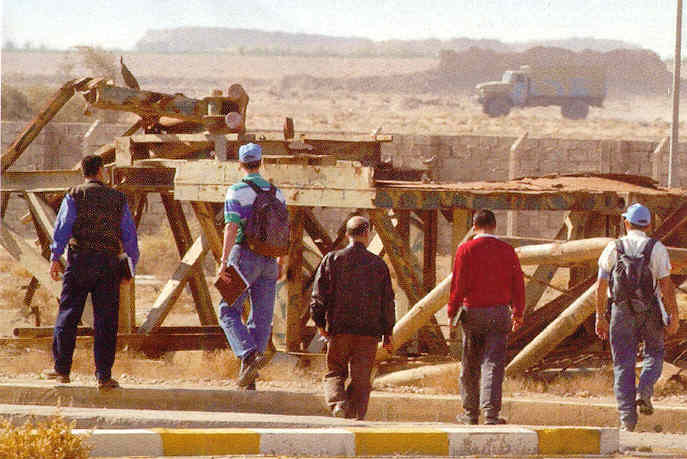 U.N. weapons inspectors in
Iraq
U.N. weapons inspectors in
Iraq
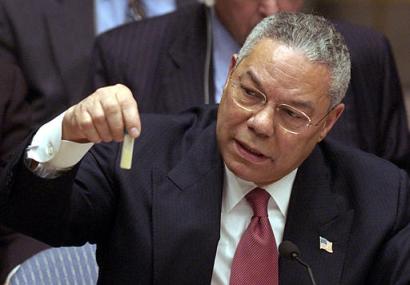
At the UN, Colin Powell holds
a model vial of anthrax, while arguing that Iraq
is likely to possess WMDs – 5 February 2003.
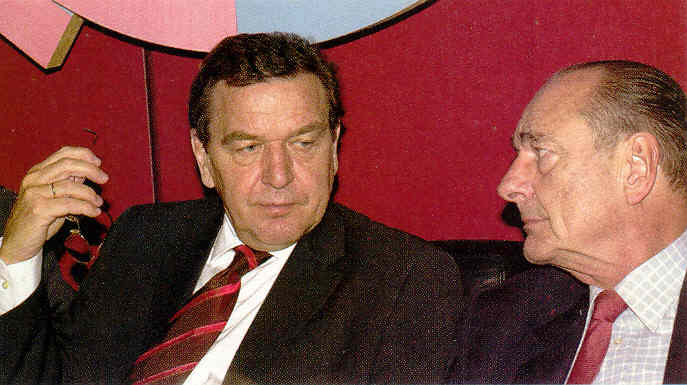
Some of America's key allies
decide that they are not with the US on the decision to invade Iraq (Germany's Chancellor Gerhard-Schröder
and France's President Jacques Chirac)
BUSH DECIDES THAT IT IS TIME FOR SADAM HUSSEIN TO
GO – MARCH 2003 |
|
The invasion (March 2003).
Nonetheless it was increasingly clear as February
turned into March that America was going to invade anyway. But now the
question arose: how and when – and with what goals – would the attack
take place?
Rumsfeld was in favor simply of a swift
attack on Iraq to destroy Saddam and his Ba'athist government and then
a fast withdrawal from Iraq as we left matters in the hands of Chalabi
and the INC. Chalabi and the INC would undertake the
"de-Ba'athification" of Iraq (similar to the de-Nazification of Germany
at the end of World War Two), the putting into place of a provisional
government led by the INC, the drafting of a constitution, the holding
of elections – and voilà, Iraqi democracy!
Rumsfeld (who was aware of how strapped
we were for men because of the ongoing action in Afghanistan) assured
the Cabinet that this all could be accomplished with a relatively small
troop size of 70 to 80 thousand American and British troops. But his
own officers were skeptical of these numbers, informing the Senate at
hearings being held at the same time as the Cabinet discussions that we
would probably need at least 200 thousand troops to do the job properly.
Also Powell and Tenet were convinced that
Chalabi was not the answer to the Iraqi problem that would emerge after
the defeat of Saddam. But they really had no alternative suggestions.
They probably were beginning to realize that with Saddam no longer in
charge, things would get very messy, very quickly. A "quagmire" as
Cheney had once said.
Turkey presented an unexpected problem.
Rumsfeld had intended to hit Saddam and his army from both the north
and the south of Iraq simultaneously. The plan was that the southern
attack would come up from allied Arab states along the Persian Gulf
(principally Kuwait). The accompanying assumption was that the northern
attack would come through the territory of our NATO ally Turkey. But
Turkey would not give its permission. Turkey was afraid (quite
correctly, as it turned out) that toppling the Saddam government would
set off Kurdish expectations for the formation finally (after dreaming
of this since after World War One in 1919) of a Kurdish nation-state.
That presented a major problem for Turkey because the southeastern part
of Turkey was inhabited by Kurds who themselves dreamed of belonging
not to Turkey but to a Kurdish nation-state. Thus Turkey was in no ways
going to cooperate – but in fact was greatly upset by America's actions
which were going to create huge problems for Turkey.1
So Rumsfeld realized that he was not going to be able to engage the
Iraqis on both fronts. However he did anticipate cooperation from the
Kurdish Peshmerga (Army) in the north of Iraq. And the Turks did give
permission at least to overfly the country to bring in a couple of
thousand U.S. airborne troops, far short of the 15,000 that Rumsfeld
had originally planned for.
On March 18th Bush gave Saddam
forty-eight hours to get himself and his two sons out of Iraq. When two
days later that had not occurred, "shock and awe" as Rumsfeld would
come to term it, began. Massive bombing of Baghdad took place, creating
a spectacular picture of the capital city lighting up the night sky
with massive flames and bomb bursts – thus "shock and awe."
In very quick order, three weeks, the
Iraqi army was destroyed. By early April the US-led coalition, which
had moved steadily north from the Persian Gulf against a retreating
Iraqi army, was at the outskirts of Baghdad. The Iraqi army was then
ordered by America to surrender – or Baghdad would suffer an even worse
fate than what it had already experienced thus far. Saddam, of course,
had vanished and thus the city and country found itself without a
leader. Thus on April 9th, the Coalition forces, principally American
and British with Australia and Poland offering smaller support,2 entered the capital city defended only here and there by small groups of resistance fighters. Baghdad had fallen.
On May 1st (2003) Bush flew to San Diego to the U.S. carrier Abraham Lincoln
to deliver a televised speech, celebrating the success of the mission –
while behind him hung a huge banner with the words "Mission
Accomplished" written on it. Those were not precisely Bush's words, and
he reminded the listeners of the work ahead of them. Yet certainly he
conveyed the idea that some kind of thrilling political achievement had
just taken place. But actually, from this point on, things would get
worse, monumentally worse – due to mistakes made by the Americans
themselves.
1This
would unfortunately mark the beginning of Turkey's pulling away from
its very strong support of America as a long-standing NATO ally – and
its new journey into Islamic traditionalism, stepping Turkey away from
its former quest for modernization on the Western model. That would
prove to be an additional huge political loss of American influence in
the Middle East caused by this enormous American blunder in Iraq.
2They
would be joined by small contributions (usually less than 100) of
personnel from 36 other countries – merely tokens of political support.
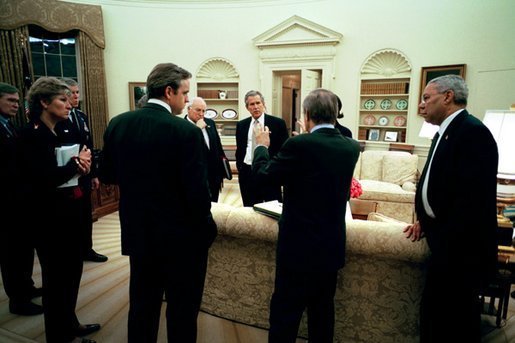
US President George W. Bush
meets with his top advisors on March 19, 2003, just before the invasion.
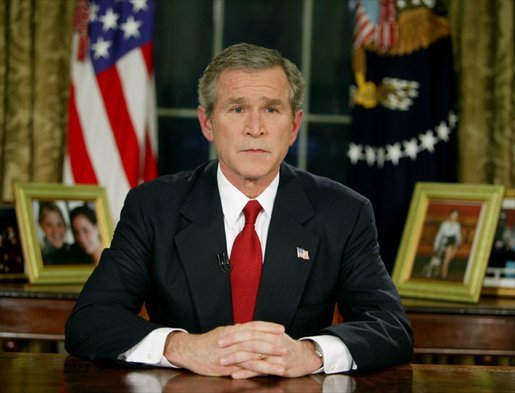
President George W. Bush
addresses the nation from the Oval Office at the White House, Wednesday evening, March
19, 2003, announcing the beginning of Operation Iraqi Freedom.
"My fellow citizens, at this hour, American
and coalition forces are in the early stages of military operations to disarm Iraq, to free its people and
to defend the world from grave danger..."
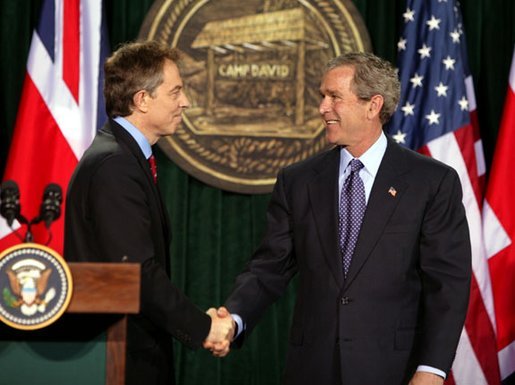
Prime Minister Tony Blair
shaking hands with President Bush, after they concluded a joint
news conference at Camp David – 27 March 2003.
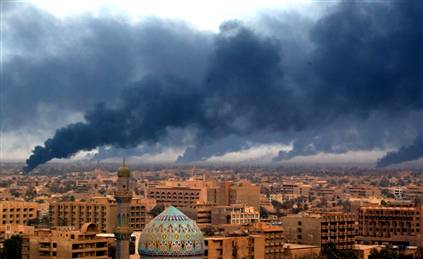
Saddam's OIl trenches burning
April 2, 2003, to cover and protect Baghdad
just prior to the US attack
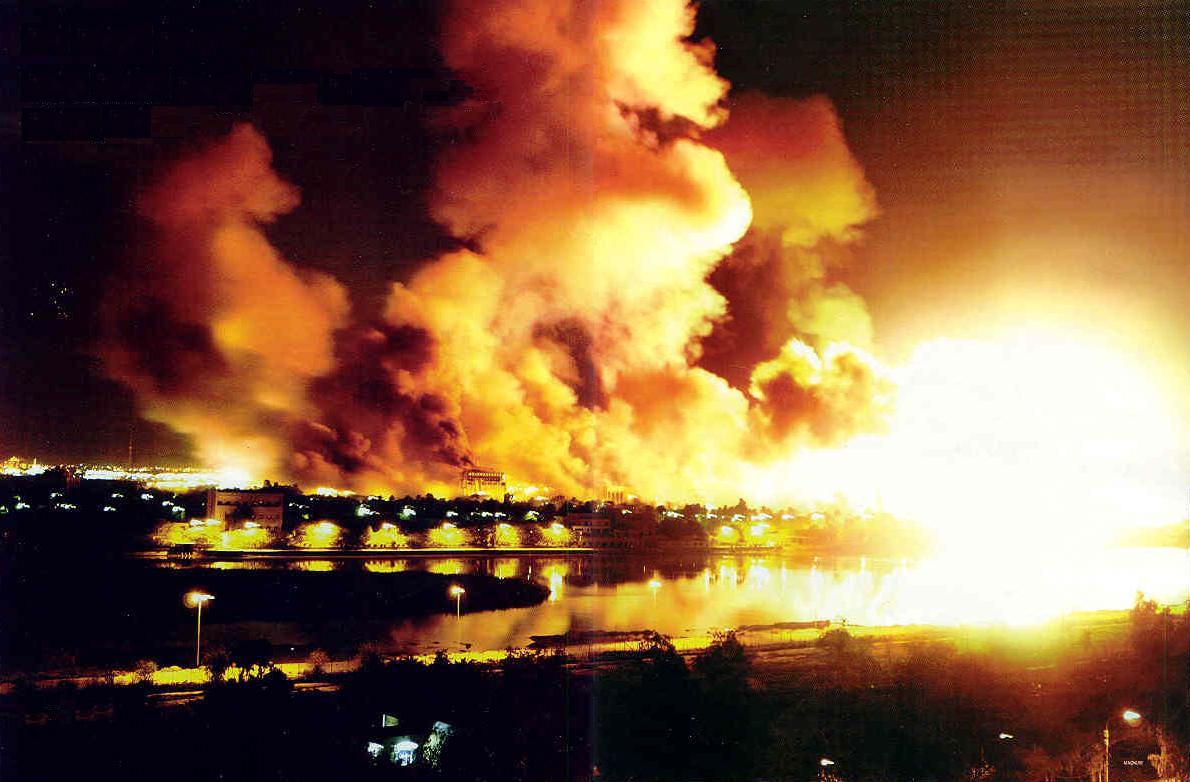
"Shock and Awe" over Baghdad
by US bombers

U.S. Forces preparing for
the ground invasion of Iraq
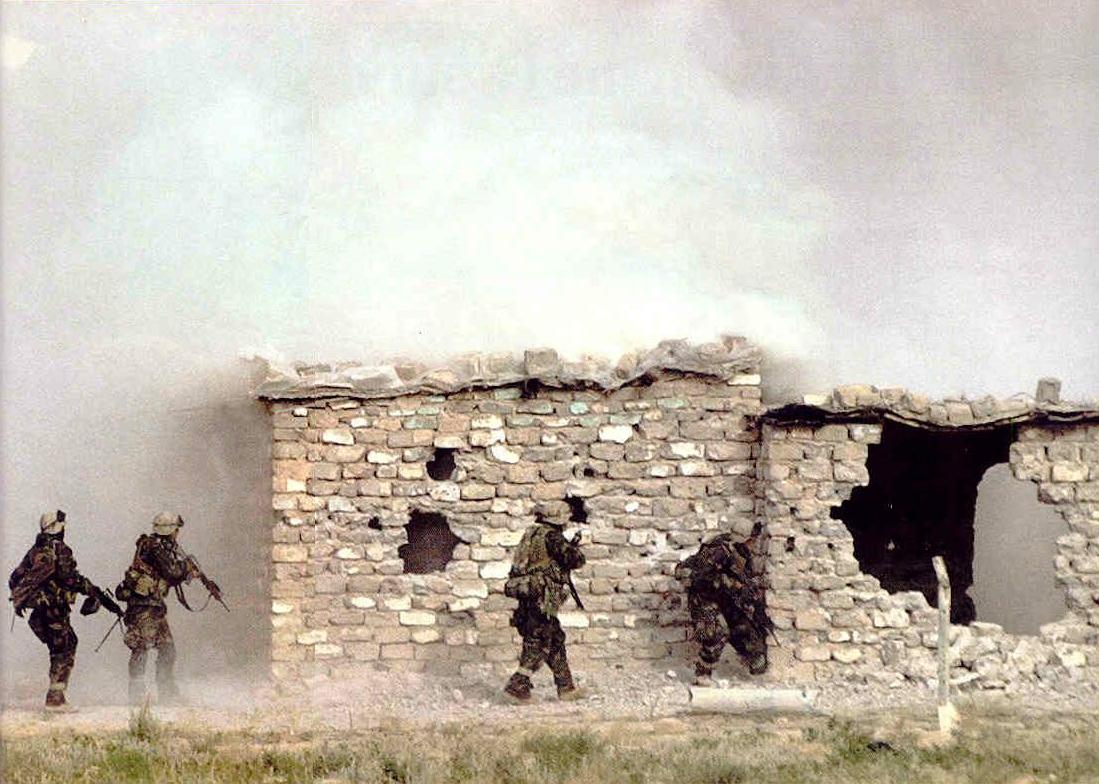
U.S. Forces going house to
house in search of Iraqi resistance
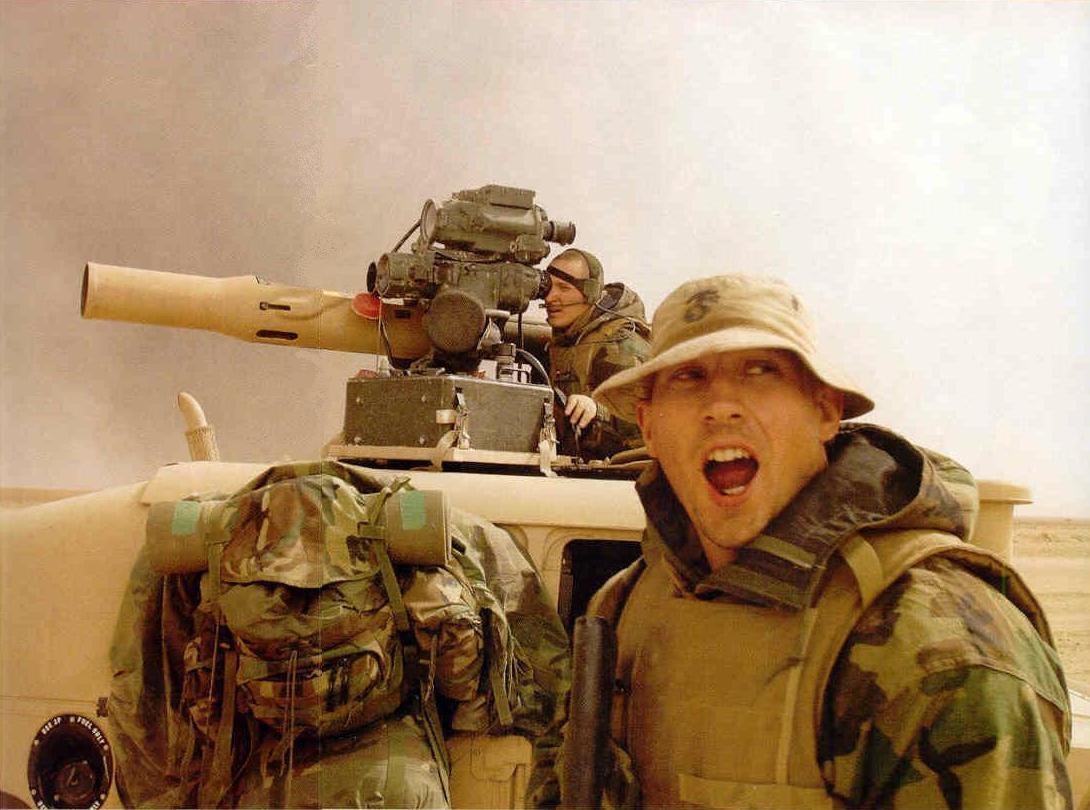
U.S. tank troops
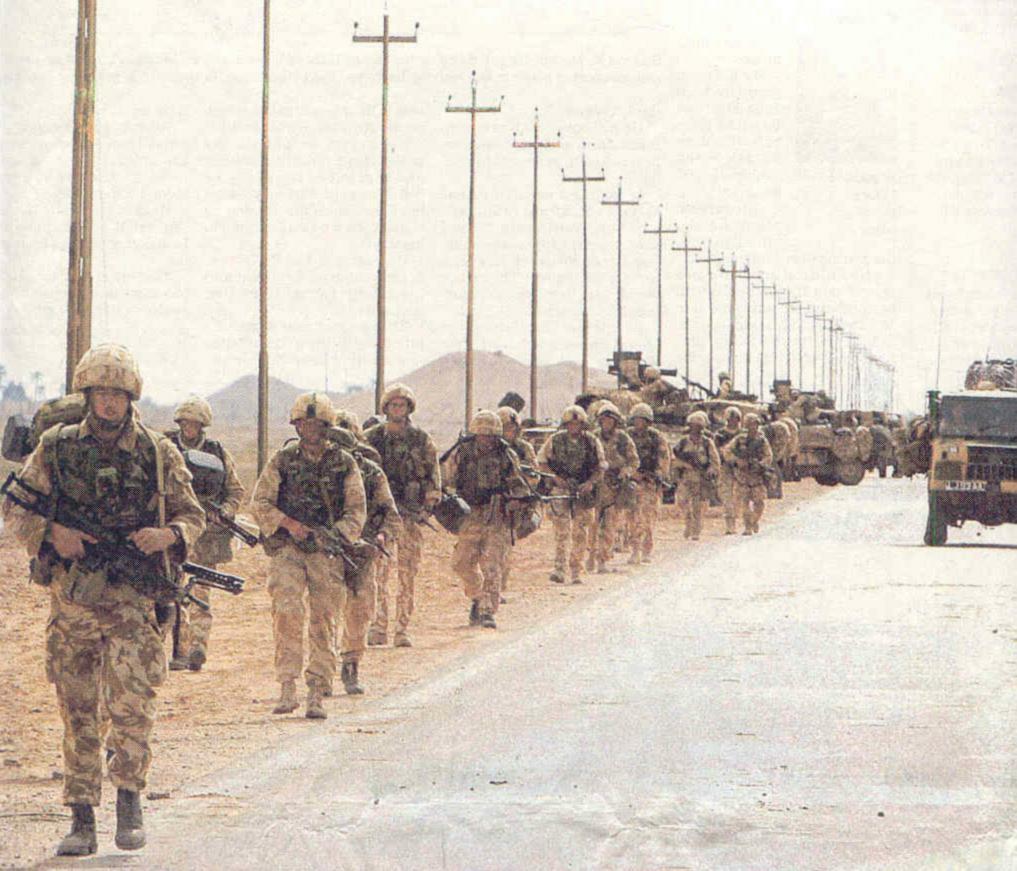
British Royal Marines travel
north in southern Iraq as allied forces fight toward Baghdad.
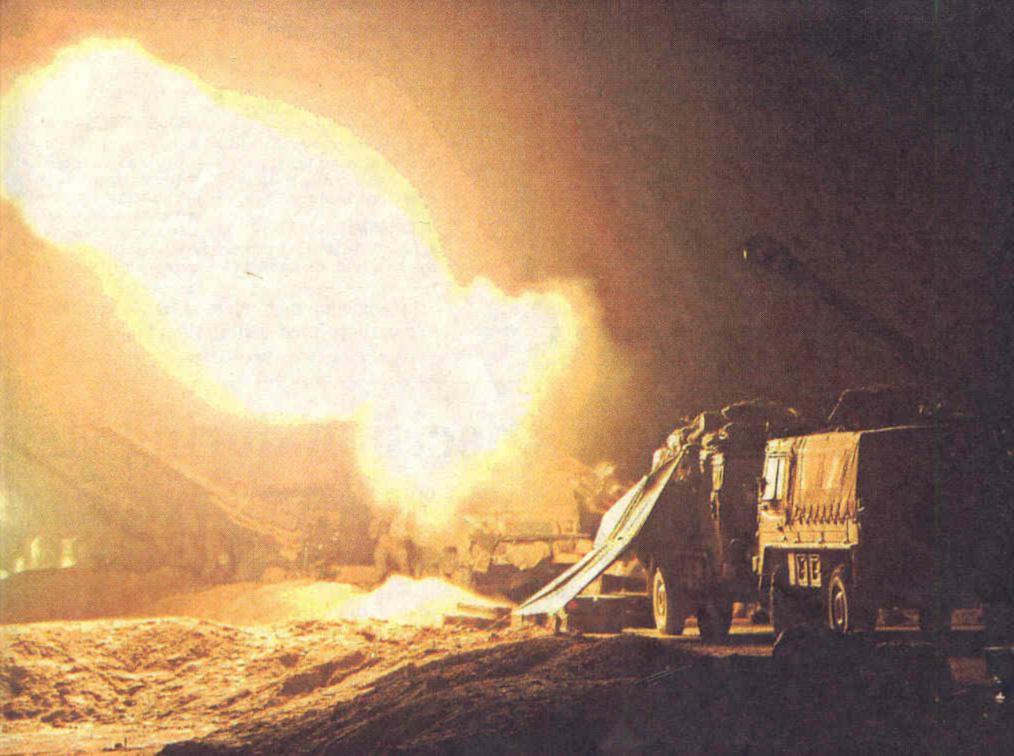
Members of the British 29
Commando Regiment Royal Artillery fire 105 mm guns in southern Iraq.
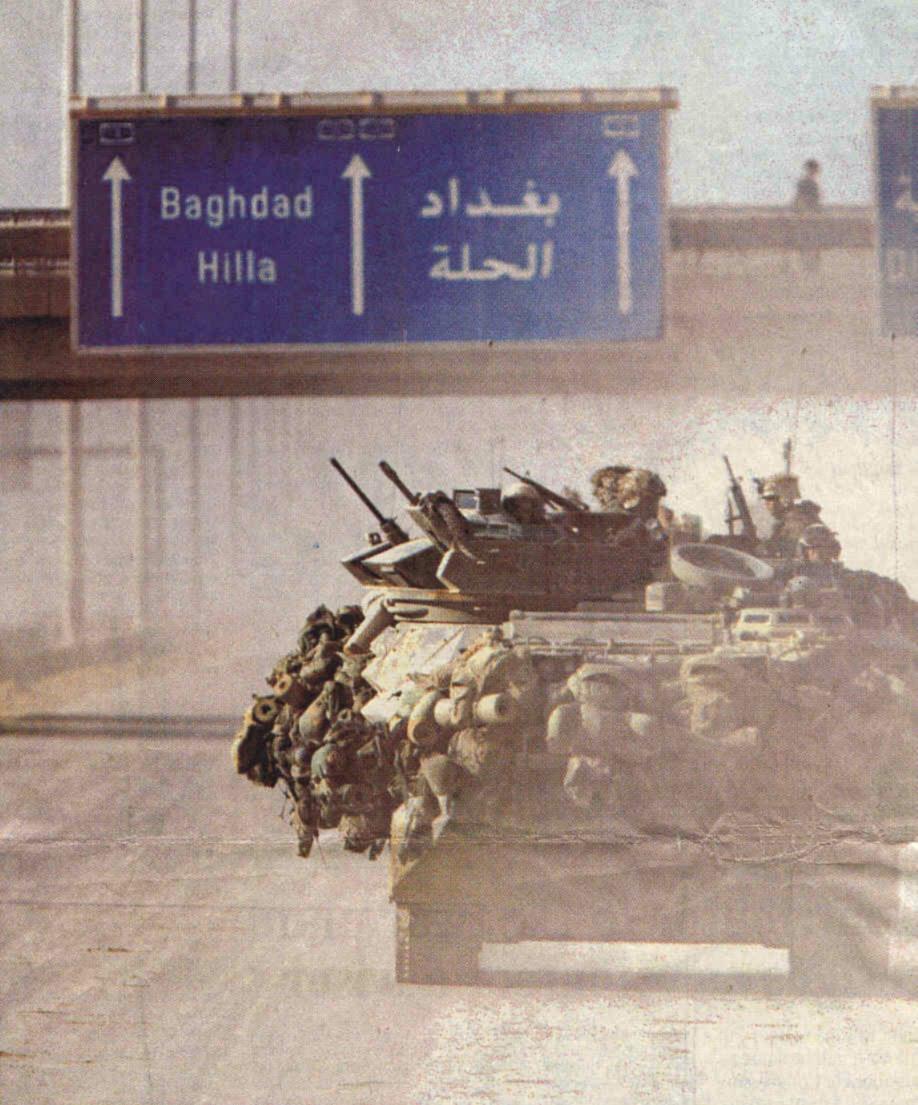
Marines from the 1st Battalion,
5th Regiment, 1st Marine Division, are on a highway to Baghdad.
Refugees flee the fighting
in Basra, Iraq's second largest city.
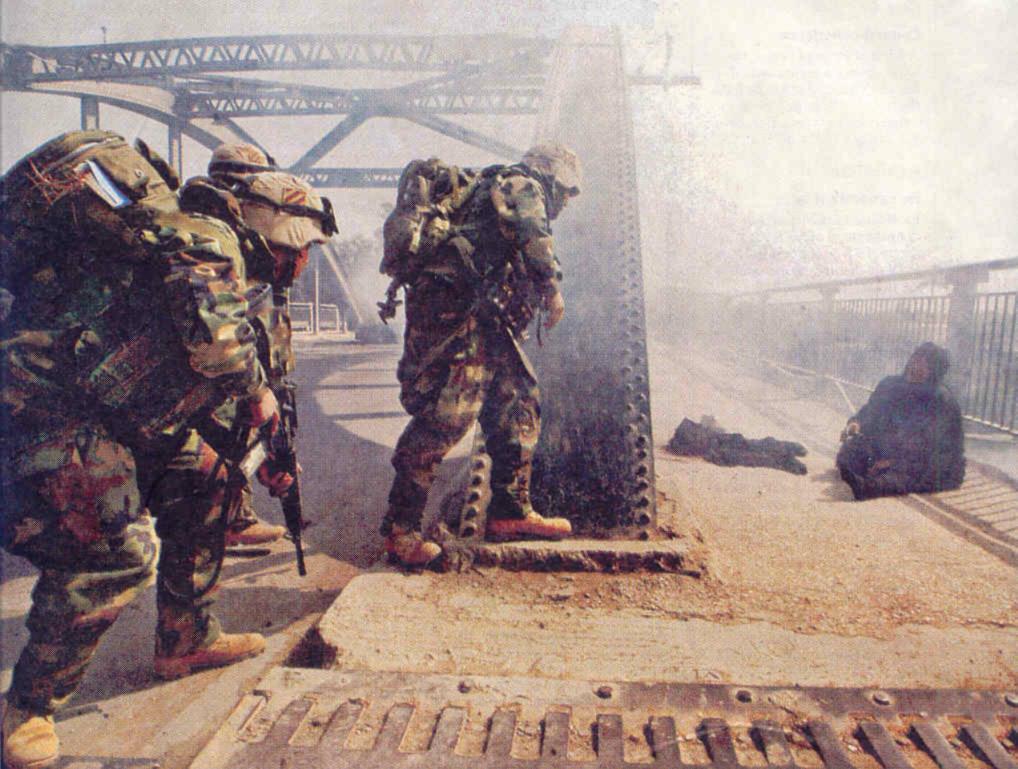
U.S. Army soldiers approach
a wounded Iraqi woman on a bridge over the Euphrates River in Hindiyah. The woman had been caught
in crossfire with Iraqi forces.
"Mission Accomplished"
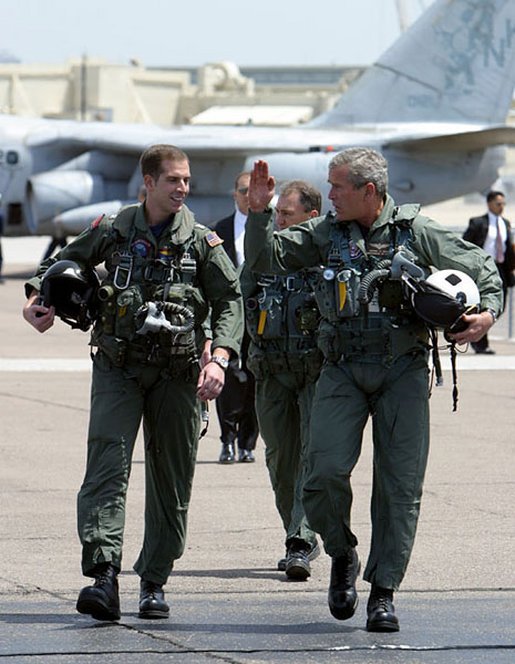
President George W. Bush
walks across the tarmac with NFO Lt. Ryan Phillips to Navy One, an S-3B Viking jet, at Naval
Air Station North Island in San Diego Thursday, May 1, 2003.
Flying to the USS Abraham
Lincoln, the President will address the nation and spend the night aboard
ship.
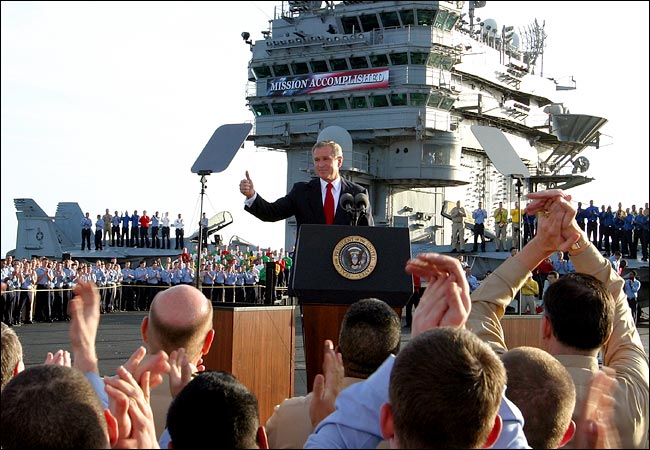 "Mission Accomplished"
"Mission Accomplished"
President Bush, after declaring
the end of major combat in Iraq, spoke on May 1, 2003, aboard the carrier Abraham
Lincoln off the California coast.
THINGS BEGIN TO BOG DOWN FOR THE U.S. IN IRAQ |
|
At first the Iraqis were ecstatic. There were
celebrations in the streets, which turned themselves into attacks on
visible signs of the Saddam regime. But these acts of anti-government
vandalism began to turn themselves into simply random vandalism. It was
clear that no one was in charge of policing the city. American Military
Police (MPs) would have been greatly helpful. But Rumsfeld had made no
plans whatsoever for policing the streets of Iraq.
Soon sectarian violence set in as Shi'ites took
out their long-building hatred of the Sunnis for the oppression they
had suffered at the hands of the Sunnis and their Ba'athist government.
And of course the Sunnis, frightened at the thought of the revenge that
the huge Shi'ite population might take against them, fought back.
Neighborhoods turned into battlefields.
This caught an uncomprehending Rumsfeld and the
U.S. military greatly unprepared. The State Department had offered its
services. But Rumsfeld did not want competition from State. His own
idea was to bring Chalabi into Baghdad, expecting to set him up in
authority with great celebration. But Chalabi was unknown to the Iraqis
and meant nothing to them. Both he and the INC proved to be worthless
in terms of how Rumsfeld had anticipated things would go politically.
Chalabi and General Garner, who had been sent by Rumsfeld to supervise
humanitarian relief, did not get along, Chalabi complaining loudly to
the Iraqi press that Garner was too friendly to the Ba'athists.
Meanwhile Baghdad continued to burn – with no
firemen, no police, no very visible authority in command of the city
... or the country.
Order No. 1.
Almost immediately a couple of political blunders – huge blunders –
occurred. In early May, a new U.S. Administrator, Paul ("Jerry") Bremer, was
brought in to try to deal with this disastrous situation. He was
another Rumsfeld appointee, though it became quickly apparent that he
intended to report to no one but himself. He was empowered to issue
decrees as he saw the need, the first one in mid-May announcing the de
Ba'athification of the country. 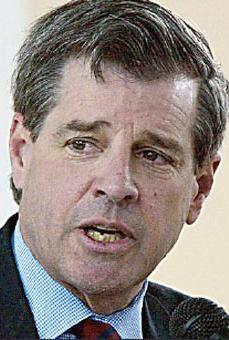 He was warned by the former
Administrator Garner not to do this. Most every civil servant,
university professor, school teacher, doctor, surgeon, civil engineer,
etc. was a Ba'athist – because membership in the Ba'athist Party had
been an absolute prerequisite to getting any kind of professional or
even semi-professional job in Iraq. But Bremer was adamant that his
Order No. 1 would stand exactly as he intended it. All Ba'athists were
to be removed from their jobs, whatever that might be. Who then with
any leadership experience among the Iraqis was going to help America
get Iraq back up and running again?
Order No. 2.
Then a week later, a yet even greater blunder occurred when Bremer
issued Order No 2, declaring that the Iraqi Army was to be disbanded.
With this, he unemployed several hundred thousand Iraqis with guns.
U.S. army officers complained that they had been counting on the Iraqi
officers to help them keep some semblance of order in Iraq and needed
their support. The Iraqi soldiers were furious, demanding back pay for
their services. But again, Bremer would not back down. With this he
created a huge unemployed sector of the population – greatly frustrated
individuals who possessed considerable knowledge about military tactics
and the use of guns. These were people ordinarily you would have wanted
on your side – not bitter and ready to oppose you by whatever means.
What was the man thinking?3
The situation deteriorates
Within a few days of the second order,
the first attack on the American forces (and British troops in the
South around Basra) occurred – the beginning of a horrible nightmare of
surprise attacks of one kind or another on troops and civilian
employees brought to Iraq to get the country up and running again. Love
of their liberators had turned fairly quickly into a seething hatred.
Meanwhile troubles were brewing within
the upper ranks of the American leadership. None of these vital
decisions by Bremer were run by either Powell or Rice – though
certainly they should have been. They were not even made with any
consultation with the American military command in Iraq. As a
result, General Franks and all of the top American generals chose to
"retire," leaving military command in the hands of an inexperienced one
star general (who was quickly promoted to three-star rank!) Ricardo
Sanchez.
Another mistake was then made, though
this time not by Bremer. Bremer wanted to take out the young Shi'ite
firebrand mullah, Muqatada al-Sadr, who was directing a growing band of
militants, drawn heavily from the slums of Baghdad, whose objective was
to hit American or British troops. But Rumsfeld (and Rice) told Bremer
to back off, apparently fearing that this might alienate the Shi'ites.
American strategy in Iraq had thus
switched from "tough" to "nice." But "nice" was not working with the
likes of al-Sadr. Indeed, al-Sadr did not refer to these American and
British troops as "liberators" but rather as "occupiers." There was no
gratitude in the militant ranks of the Shi'ites for the toppling of
their cruel persecutor Saddam. Their sole thought was to take advantage
of the chaotic situation and get themselves in power as soon as
possible. The Americans and British were now simply in their way. They
wanted control – not "civil rights."
Even more problematic, in no way were
they going to direct the majority Shi'ites to cooperate with the
American and British effort to bring "democracy" to Iraq – even if that
were to prove to be a Shi'ite majority (which indeed it would). To
al-Sadr and his supporters, America was simply the Great Satan come to
Iraq – viewed in exactly the same way as their Shi'ite colleagues next
door in Iran viewed America. To al-Sadr, what Iraq now anticipated was
not the blessing of democracy but the divine blessings that would come
the Shi'ite's way in doing very serious moral-spiritual damage to the
Great Satan America.
How Rumsfeld could effectively deal with
such anti-American ideological dedication would be a huge mystery to
American troops in Iraq – not to mention White House decision-makers
back in Washington.
At the same time, the Sunnis –
concentrated in the northwest of the country – were furious at the
Americans for having turned the Sunnis out of power in favor of the
huge population of greatly-hated Shi'ites. The Sunnis were well-aware
that American efforts to "democratize" Iraq would lock the Sunnis in a
perpetual minority status. Thus the Sunnis hated the Americans as
deeply as did al-Sadr's Shi'ites.
America had marched itself into a lose-lose situation.
Then there were the Kurds in the
northeast, happy with the Americans for having given them the
opportunity to break away from Arab Iraq – although that was not part
of the intentions of the Americans. Indeed, such Kurdish independence
sentiment would only serve to further undermine America's relationship
with its old ally Turkey.
What a confusing mess America had just set loose in the heart of the
Middle East! Bush and the neocons never saw that coming … well
possibly with the exception of Cheney, who was well-aware of the
potential "quagmire" awaiting Americans in Iraq. But political
opportunism in the Bush, Jr., White House had blinded him – or simply
given him political amnesia – so as to cause him to ignore the obvious
problems that awaited Americans in a post-Saddam Iraq.
The original case for invasion collapses
Meanwhile the search for the famed WMDs
was not going well at all. As time passed the frantic search for the
objects that had "justified" the American invasion of Iraq was yielding
no results – not even the hint of WMDs. But Tenet and Powell had staked
their reputations on the intelligence that claimed that these existed
(much of it fed by Chalabi, who was in a hurry to get Americans
involved in toppling the hated Ba'athist regime).
Then in July 2003 an article appeared in The New York Times
by a retired U.S. diplomat, Joseph Wilson, stating that the "yellow
cake" nuclear material that Powell had made such a big deal of to the
U.N. Security Council in fact never existed. How did he know? A week
later The Washington Post
came out with the story that it was the diplomat's wife, Valerie Plame,
a CIA operative, who had passed on the information to her husband. This
raised another question. Who had given the Washington Post
the information "outing" her as a CIA agent and thus effectively ending
her career? The whole thing turned into a massive spy scandal – not to
mention huge embarrassment to the Bush Administration.
But this was just one part of the case
for the invasion that was rapidly collapsing. Other intel leaks begin
to appear, embarrassing the White House further. Finally, to deflect
the heat, Tenet was asked to resign as CIA chief. He would be assigned
the blame for the WMD fiasco!
A new round of fighting in Iraq erupts
By the summer of 2003, Iraq seemed to be
back again at full-time war. The Jordanian embassy and the U.N. and Red
Cross headquarters in Baghdad were blown up and insurgents were
attacking U.S. troops and U.S. civilian workers everywhere. Further,
the American troops were prepared only to fight uniformed Iraqi troops.
Now, as in Vietnam, the insurgents (both Sunni and Shi'ite) who were
attacking them were indistinguishable from the civilians the American
troops were supposed to be protecting. And Rumsfeld's plans to begin
the reduction of the American troops presence in Iraq were now on hold.
But what to do at this point was not in the Pentagon's planning book.
Saddam captured (December 2003)
However, finally in December, Saddam was
found hiding in a hole in the ground at a farm near his hometown of
Tikrit. It was hoped that his capture would appease the Shi'ite
insurgents and break the spirit of the Sunni insurgents. Neither thing
resulted.
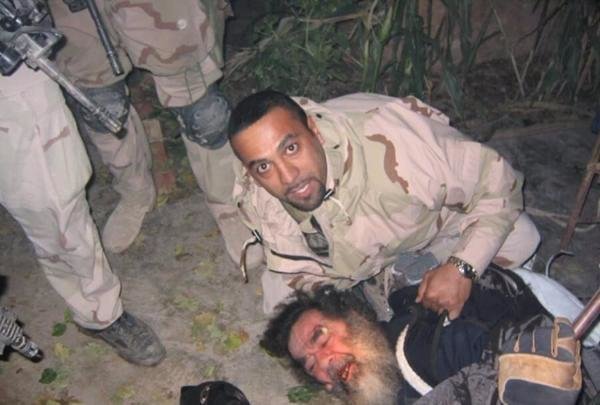
3In
December of 2004, an incredibly ill-informed President Bush presented
Bremer America's highest civilian honor, the Medal of Freedom, stating:
"For fourteen months Jerry Bremer worked day and night in difficult and
dangerous conditions to stabilize the country, to help its people
rebuild and to establish a political process that would lead to justice
and liberty." However, at this point Iraq was hardly "stabilized" nor
experiencing justice and liberty – due mostly to Bremer's massive
political ineptitude. Bremer, however blamed the very obvious Iraqi
catastrophe on the inadequate American military support he was expected
to work with. Working with the Iraqis themselves was way beyond
Bremer's understanding or abilities.
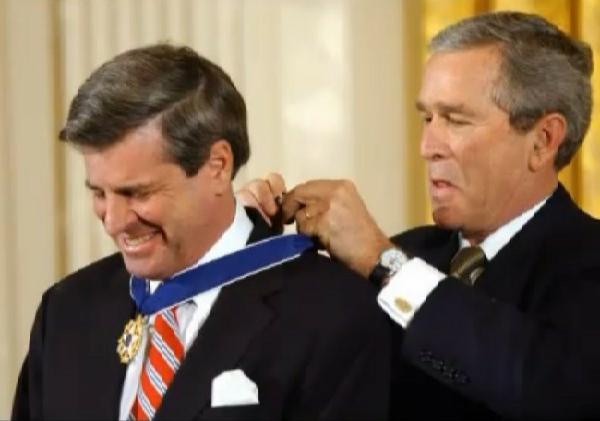
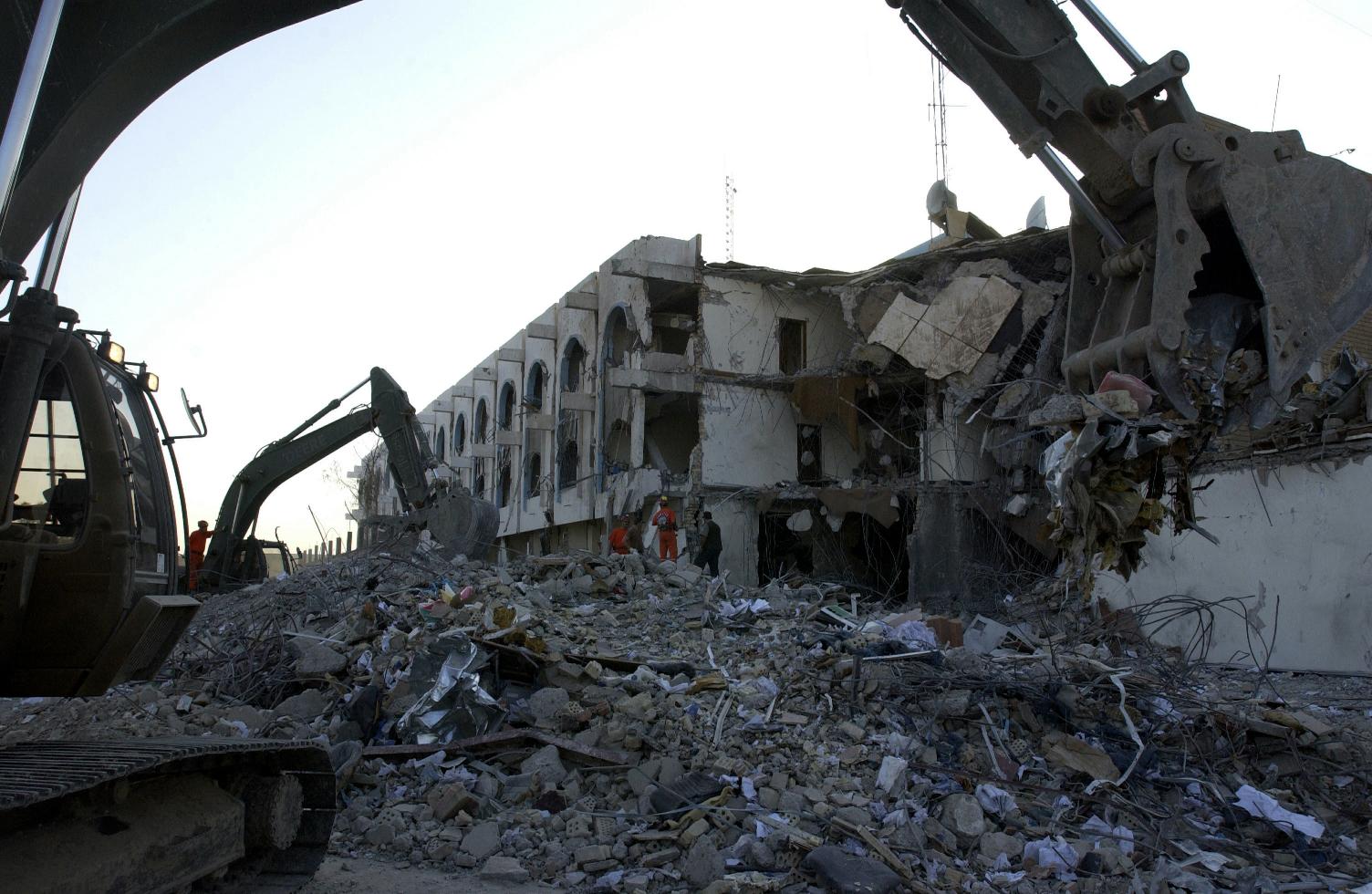
Rescue workers search for
victims at the United Nations (UN) Office of Humanitarian Coordinator Building in Baghdad, Iraq,
after a truck bombing destroyed
much of the building – 22 August 2003.
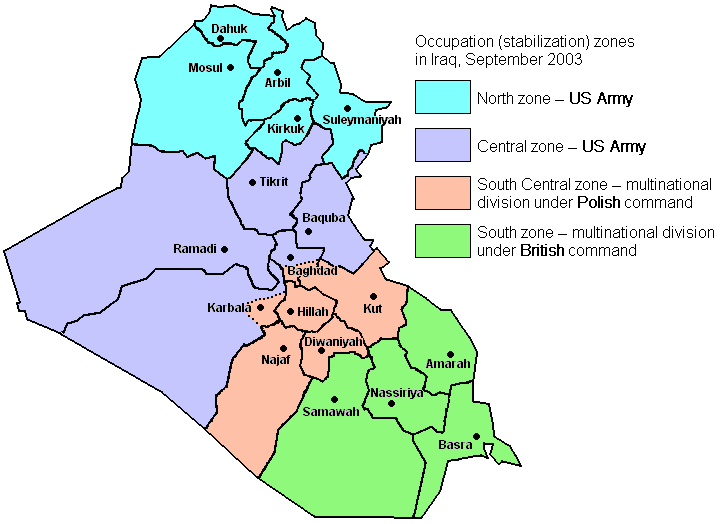 Occupation zones in Iraq
as of September 2003
Occupation zones in Iraq
as of September 2003
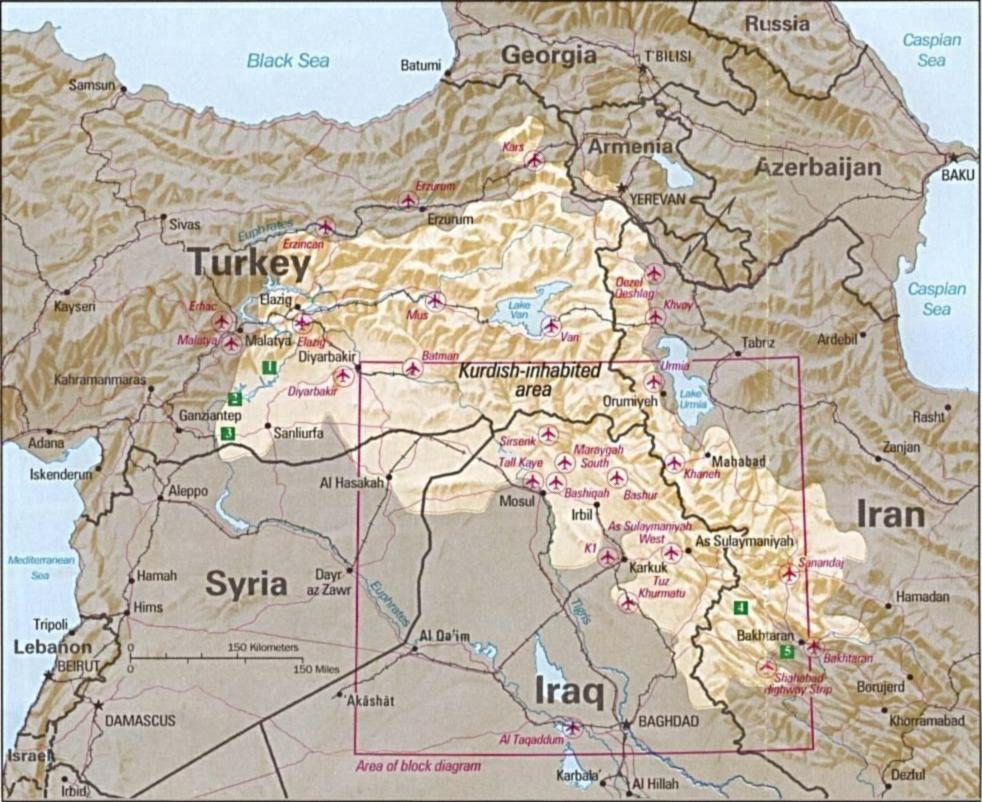
Kurdish-inhabited area by
CIA (1992)
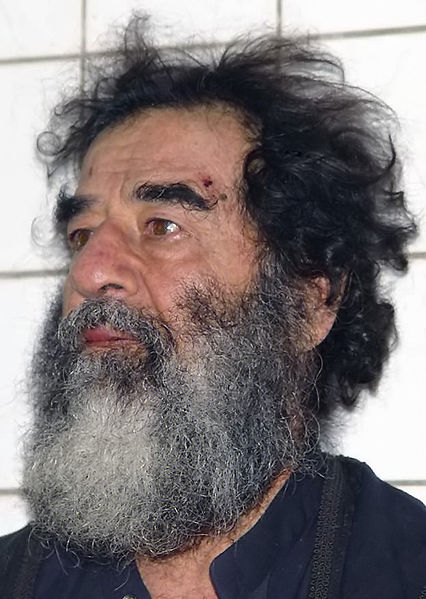 Saddam Hussein (14 December
2003) shortly after his capture
Saddam Hussein (14 December
2003) shortly after his capture
2004: THE SITUATION IN IRAQ WORSENS |
|
2004 – mounting problems in dealing with the local population
Tragically, the following year things only got
worse in Iraq. Sweeps through villages in search of insurgents brought
huge outcries from the local population. But America couldn't fight
back without being able to identify the enemy. America was heavily
dependent on the local people to identify the insurgents. But such
assistance from the Iraqis was just not forthcoming.
Frustrated by a war without identifiable
enemies, Rumsfeld ordered the ghastly Saddam prison Abu Ghraib to be
used to squeeze any information possible out of captured insurgents.
But that idea would soon turn into another huge American embarrassment
– when extremely gross pictures of the methods used to break Iraqi
prisoners were leaked to the American press that spring. And by the
summer pictures of these acts were everywhere.
Also by that time al-Sadr (who was now being
financed heavily by the Islamic Republic of Iran) was attacking Western
troops with a "Mahdi Army" of several thousand insurgents. Likewise,
huge areas of Sunni Arab Iraq were under the control of local
insurgents. By this time, even Baghdad was a very unsafe city. Only the
Kurdish north was relatively calm.
The White House was desperate for some good
news. Besides, 2004 was a presidential election year and the single
biggest, even overpowering, issue in the electoral campaign was
definitely Iraq.
A bit of good news finally came out of Iraq at
the end of June when Bremer was able to announce the formation of a
provisional government and an interim constitution. Also General Casey
had replaced Sanchez – and although Casey had never led American troops
in combat, he would prove to be an effective fighting general against
the insurgency.
Meanwhile Rumsfeld had ordered a shift in the
American military strategy – to step American troops back from a
forward strategy and to return them to base (the "small footprint"
strategy). American troops would now serve merely as something of an
anchor to – and instructors of – Iraqi troops, who were to take over
the duties of policing Iraq as soon as possible. This was also in line
with the idea that American troops would soon be departing Iraq –
something Rumsfeld had wanted from the very beginning of the invasion.
|
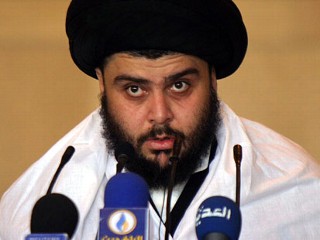 Shi'ite cleric and anti-American resistance leader Muqtada
al-Sadr
Shi'ite cleric and anti-American resistance leader Muqtada
al-Sadr
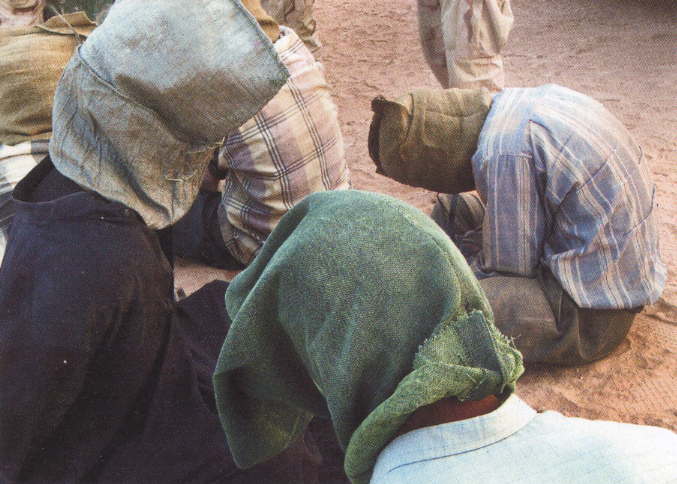 Hooded Iraqi
prisoners
Hooded Iraqi
prisoners
 A picture of an Iraqi prisoner
at Abu Ghraib prison who was told that he would
be electrocuted if he stepped off the box (not true – but convincing
torture to a hooded prisoner nonetheless)
A picture of an Iraqi prisoner
at Abu Ghraib prison who was told that he would
be electrocuted if he stepped off the box (not true – but convincing
torture to a hooded prisoner nonetheless)
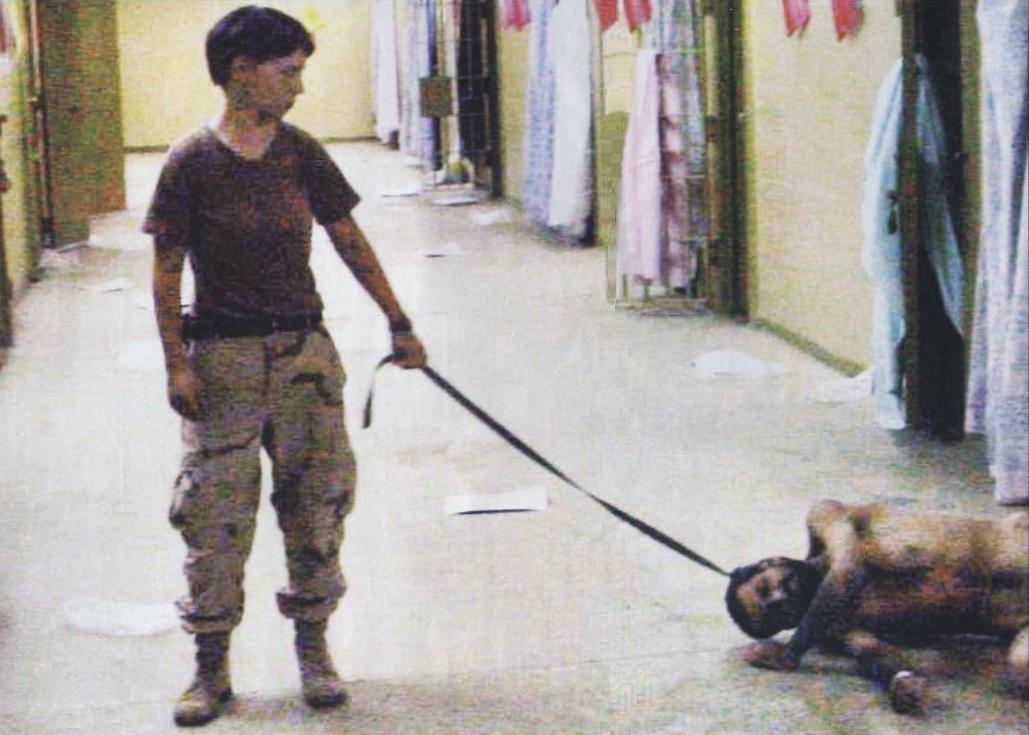
Private Lynndie England with
an Iraqi prisoner on a leash at Abu Ghraib prison in Baghdad
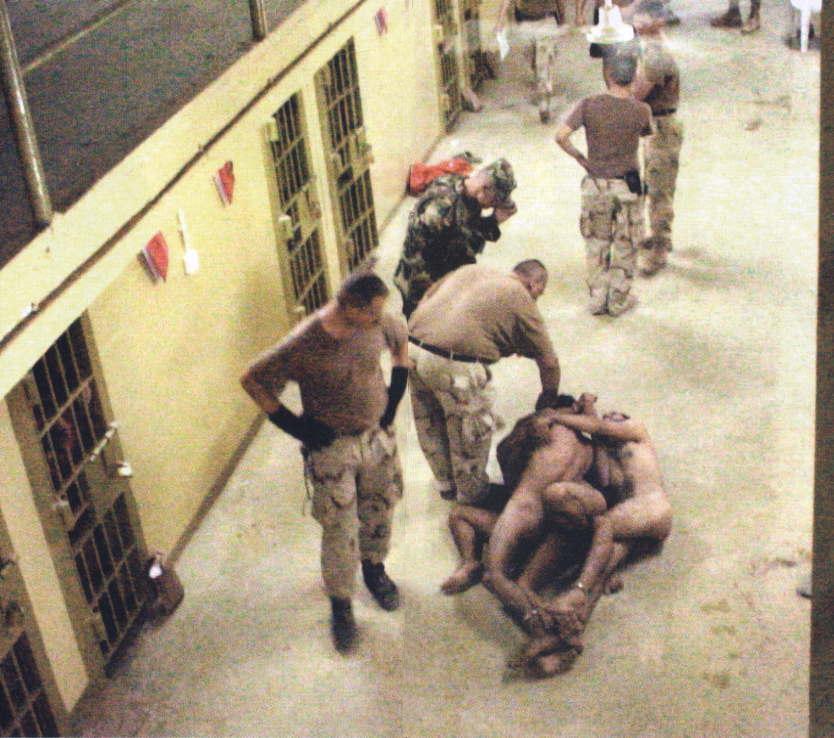
Naked Iraqis naked and bound
together under US troop supervision
THE 2004 PRESIDENTIAL ELECTION |
|
The 2004 American presidential campaign not only
focused heavily on the Iraq issue – but also on the issue of the
integrity of the candidates, Bush and the Democratic Party candidate,
John Kerry. It got very personal.
A growing storm over John Kerry's
military record was brewing by the end of the summer. Kerry had served
for four months in Vietnam in the late 1960s as the commander of a
Swift boat, a shallow draft boat that patrolled the rivers of Vietnam.
Kerry received a number of medals for wounds and for actions under fire
– which in the 2004 campaign a number of Swift boat veterans stepped
forward to challenge as to their true worthiness. Certainly also part
of the irritation with Kerry by these veterans was the testimony that
he made before the U.S. Senate in 1971 about war crimes committed by
fellow American soldiers in Vietnam – which first brought the
27-year-old Kerry to national attention. The "swift boaters" claimed
that Kerry had not been telling the truth about the circumstances by
which he had received his medals – and thus was unfit to command,
especially as President. But this claim was strongly contested by some
of Kerry's own men who had served directly under him, claiming that
Kerry's military record and awards were truly authentic. Nonetheless,
the scandal had a tremendous impact – and sank Kerry's popularity
considerably.
Then in September, less than two months
before the election, Dan Rather of CBS's 60 Minutes program came out
with documents which pointed to Bush's own very questionable military
performance back in the early 1970s as a member of the Air National
Guard. But it was soon revealed that these documents had not been
authenticated by CBS – and were in fact written in a type script which
did not come out until the development of the personal computer 10
years later. CBS was humiliated and apologetic. Interestingly, CBS had
planned to come out with a program at about that same time very
critical of the Bush Administration's decision to go to war in Iraq,
but had substituted the Rather report instead. The flack over the
Rather report subsequently caused CBS to postpone the program until
after the elections. Had it gone forward, it might have done some
serious damage to the Bush re-election campaign.
The election resulted in a 286 electoral
vote (a 50.7 popular vote) for Bush and a 251 electoral vote (a 48.3%
popular vote) for Kerry. Despite the growing unpopularity of the War in
Iraq, Bush was returned for another four years to the presidency. Also
in the election, the Republicans in the House actually increased their
majority by 3 seats, 232 to 201 and increased their majority in the
Senate by 4 seats, 55 to 45.
|
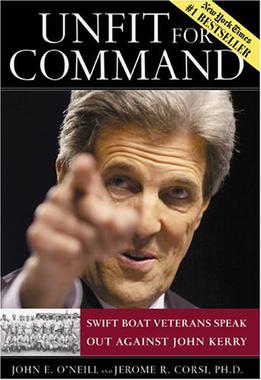
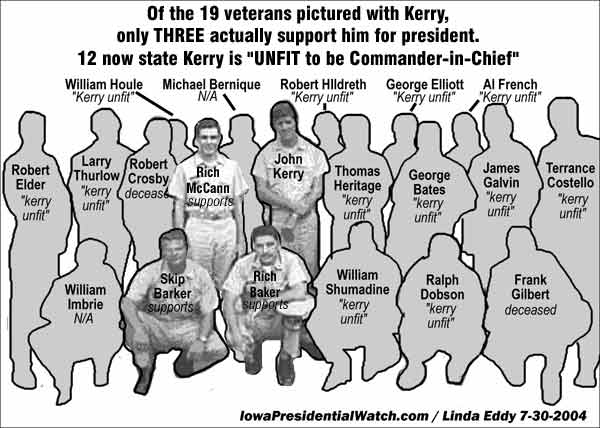
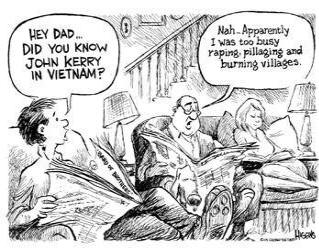
An anti-Kerry cartoon
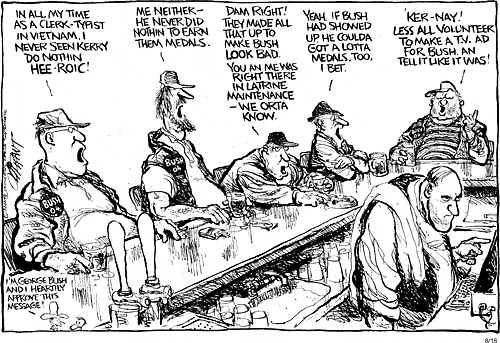
Pro-Kerry cartoon attacking his attackers!

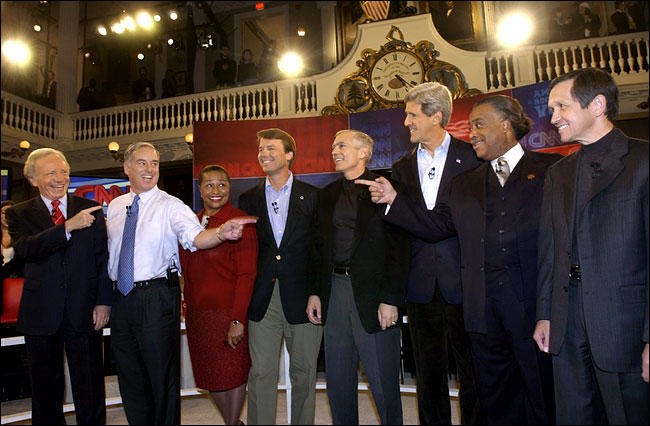
The Democratic hopefuls at
the Rock the Vote debate on Nov. 4, 2003, at Faneuil Hall in Boston.
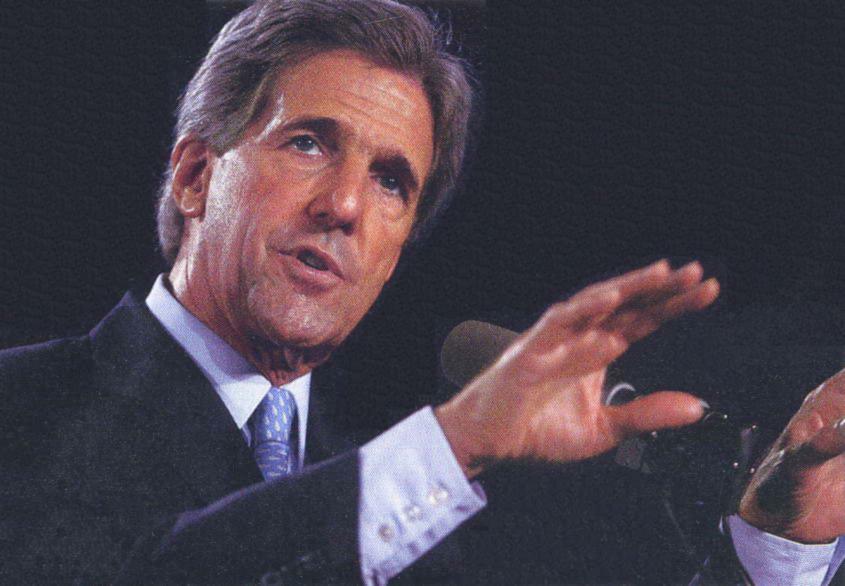
Democratic candidate
Massachusssetts
Sen. John Kerry
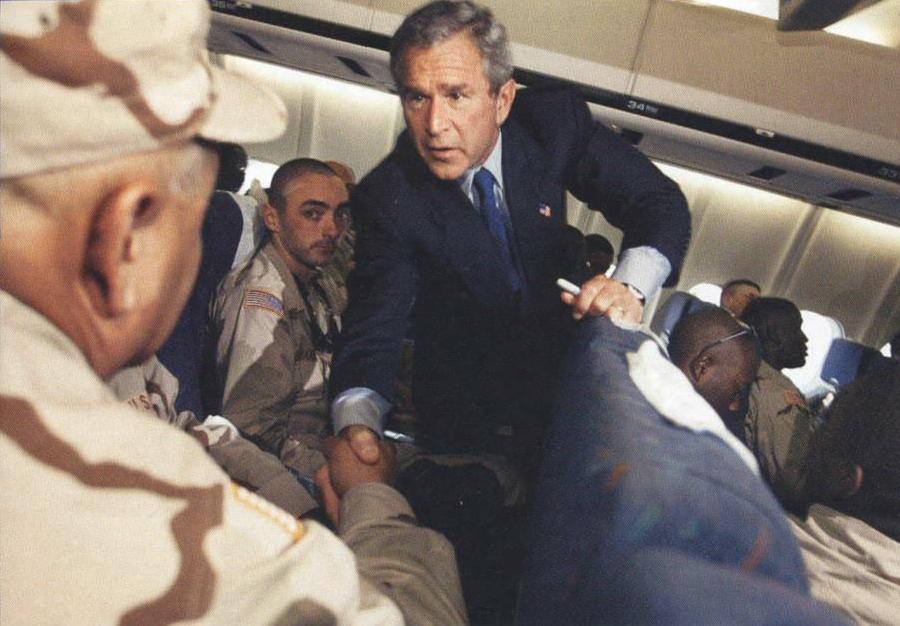
Pres. Bush campaigning as
Republican candidate for re-election
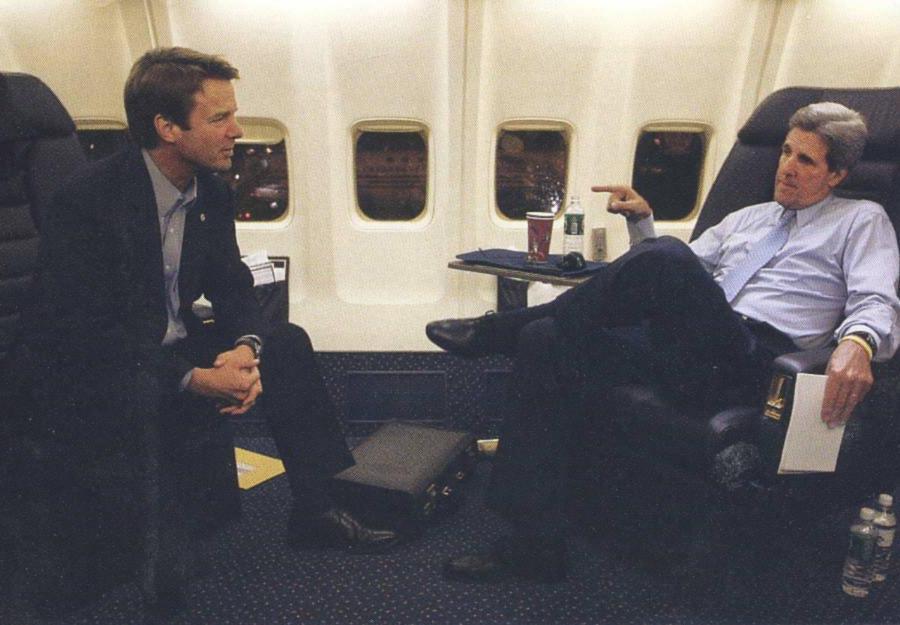
Sen. John Kerry on the campaign
trail with his Vice-Presidential running mate Sen. John Edwards
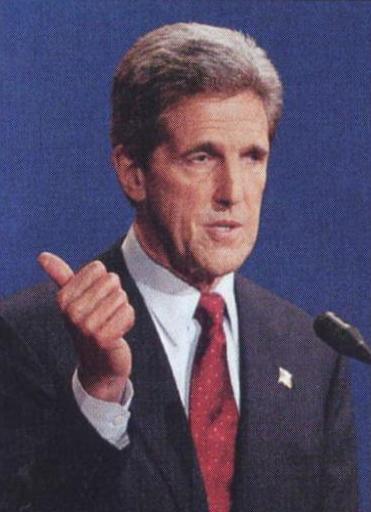 Sen. John Kerry speaking Sen. John Kerry speaking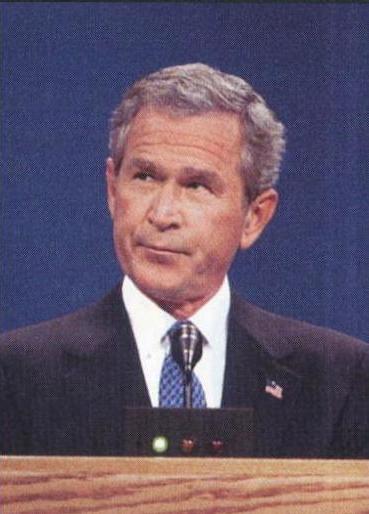 Pres. George W. Bush looking very annoyed
Pres. George W. Bush looking very annoyed

The results
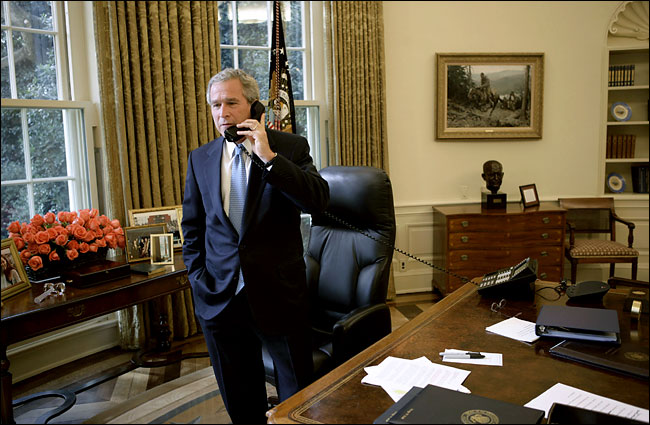
Bush receives a phone call
from Kerry, who conceded the presidential election, November 3,
2004
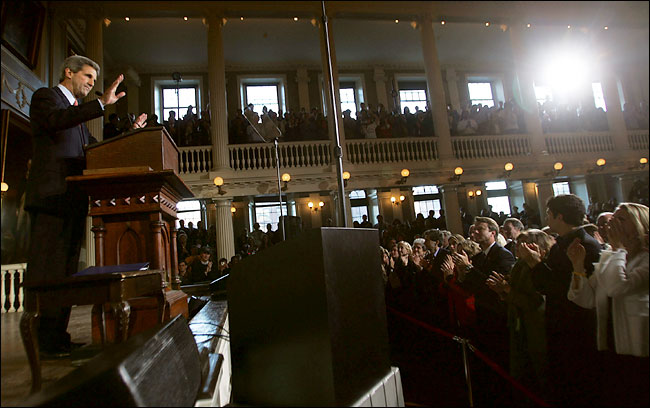
Kerry presenting his concession
speech at Faneuil Hall in Boston, November 3, 2004
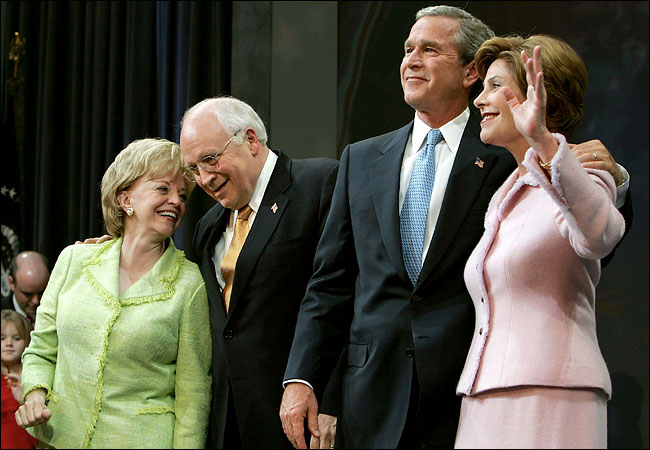
President Bush with the first
lady, Laura Bush, and Vice President Cheney with his wife, Lynne, celebrating their election
victory Newsweek, November
15, 2004
 Newsweek, November
15, 2004
Newsweek, November
15, 2004
THE IRAQI "QUAGMIRE" DEEPENS (2005-2007) |
|
The Situation Continues to Deteriorate in Iraq
But for Bush and America (and the Iraqis) the
situation in Iraq was deteriorating. Rumsfeld had departed from his
"small footprint" strategy to launch a crushing attack on al-Sadr, who
then backed off – with also an accompanying American payment for doing
so. Thus it seemed that a hard American hit, plus some money, worked
just fine for al-Sadr – though the arrangement did not usually last
long before he was back at it again. This pattern of dealing with
al-Sadr got to be a regular feature of America's relations with the man.
Meanwhile, the problem in the Sunni town
of Fallujah (immediately west of Baghdad) was much more serious. Soon
after the November election the Americans hit the town hard, nearly
destroying it – making the point clear that America could be tough if
pushed. Things quieted down in Fallujah. But soon Rumsfeld was back at
his original strategy. He would be returning troops back to the small
footprint status.
But tensions were growing within the Bush
Cabinet about this strategy. Powell and Rumsfeld disagreed strongly
over Iraqi strategy. At this point Bush knew that one or the other was
going to have to go. Rice and Andy Card, Bush's White House Chief of
Staff, felt that Rumsfeld should be the one to step down. Cheney, of
course, felt otherwise – that Powell had to go. Finally the President
decided: it would be Powell. In mid-November (2004) Powell was
dismissed – and Rice took his place as the new Secretary of State.
2005 – The tragic drama continues
On January 1st, Iraq held its first
national election under the new regime. Iraqis were voting for a
Provisional Government that would draft a permanent constitution for
the country. The Sunnis largely boycotted the elections (only 10%
voted), seeing this election simply as a confirmation that Shi'ites now
controlled the country. Thus the democracy that the Bush Administration
had hoped would bring a mood of peaceful unity to Iraq instead merely
highlighted the huge religious or cultural divisions that ran through
the country. Worse, the fighting did not subside with this opportunity
for democracy, but merely intensified. By mid-2005 the Sunni-Shi'ite
dispute was turning itself into an all-out civil war.
And most ironic of all, al-Qaeda had slipped into the Iraqi power vacuum to encourage the Sunnis to attack Shi'ites everywhere.
By October the new constitution was ready
and in the middle of the month Iraqis went to the polls to ratify this
new constitution. The Sunni vote was a "no" vote, but light enough that
only two of the eighteen provinces voted no – not enough to block
passage of the constitution. Thus in December, another round of
national elections was held, this time for a new Iraqi National
Assembly. A coalition government was formed under a new Prime Minister,
Nouri al-Maliki, a strongly Shi'ite politician. Interestingly,
Chalabi's party that Rumsfeld had been placing so much hope on received
not a single seat in the new National Assembly!
2006 – The situation continues to deteriorate
In February of 2006, a small group of men
succeeded in blowing up the Al-Askari or Golden Dome Mosque in Samarra,
one of the most holy mosques in Shi'ite Islam. In revenge the Shi'ites
attacked Sunni mosques and killed Sunni clerics. Al-Sadr was back in
business brutalizing Sunnis wherever he could. And al-Qaeda-inspired
Sunni death squads were busy answering back the Shi'ite death squads.
Iraq was spinning out of control.
Meanwhile the program announced in May
2006 called "Operation Together Forward" (the handing over of
responsibilities to Iraqi authorities and military units) continued.
The British turned over one of the southern provinces and a military
camp to local Shi'ite authorities in July and August. And America
turned over one of its bases in the north to local Kurdish authorities.
Meanwhile al-Sadr bragged that they were "kicking out" the occupiers.
But the situation around Baghdad was only
worsening and the Western province of Anbar seemed totally beyond
American control – al-Qaeda now largely in such control as there was
over this province! American troops even had to be sent south into
areas turned over to Iraqi authorities in order to suppress insurgent
attacks on Iraqi troops. The job of maintaining Iraqi security seemed
to be yet well beyond the ability of the Iraqi troops.
The situation in Iraq seemed grim – and
there was an American congressional election coming up in November.
Rumsfeld's strategy was clearly not working and American voters had
become deeply disenchanted with Operation Iraqi Freedom. Three years
after the invasion – despite there having been elections in Iraq –
"Iraqi freedom" seemed as distant as ever.
The 2006 U.S. Congressional elections
The elections on November 7th hit the
Republicans hard. Thirty seats were lost by the Republicans to the
Democrats in the House and six in the Senate. The Democrats now
possessed a majority in the House of Representatives; and though the
Republicans had lost the Senate to merely a tie, two independents
joined the Democratic Party caucus. This was a big loss for the
Republican Party. The disenchantment with the war in Iraq was clearly
to blame for their defeat.
The day after the elections Bush
announced that Rumsfeld would be replaced by CIA Director Robert Gates.
The Republicans were upset: why hadn't this change been announced
before the elections? It might have lessened the Republican catastrophe.
|
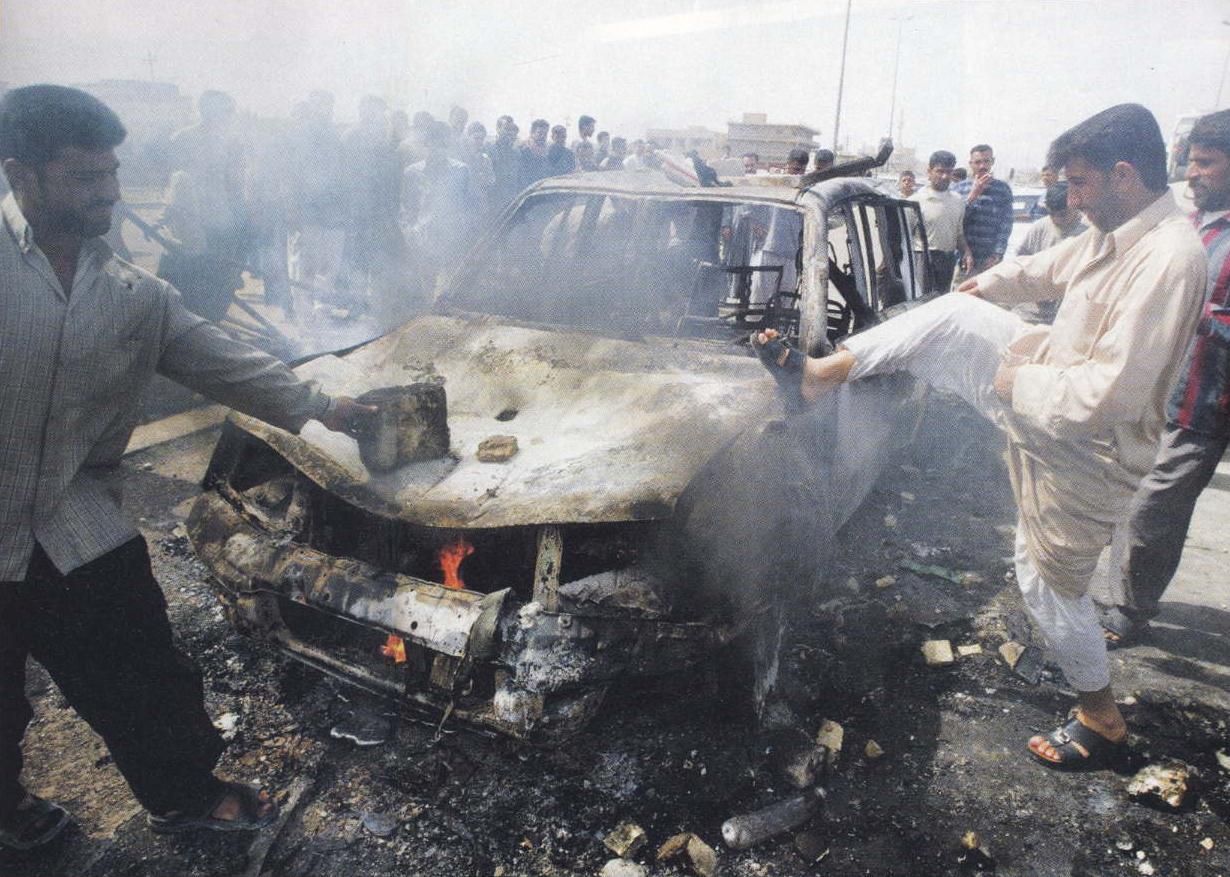
Iraqis in Fallujah burning
a vehicle of a US security contractor
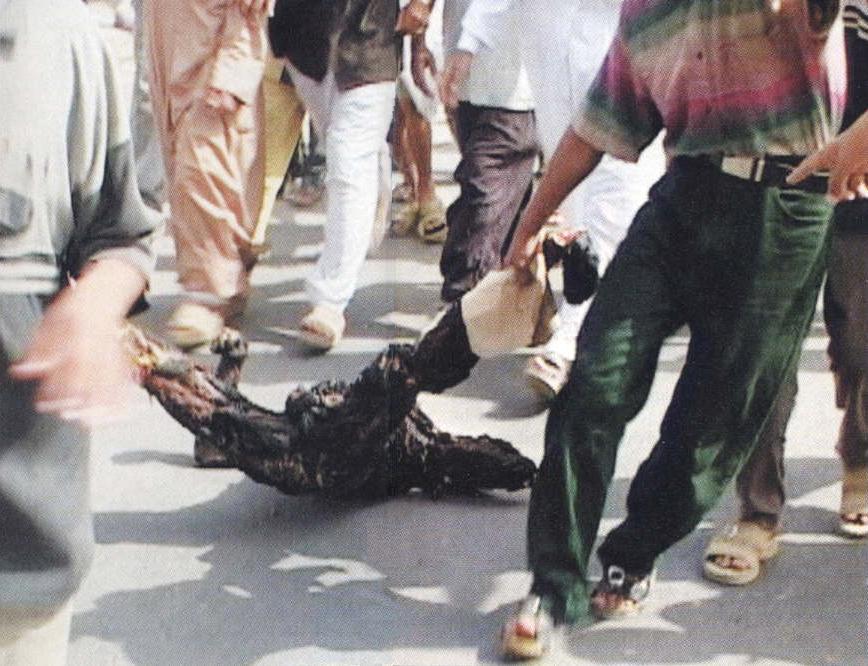
Iraqis in Fallujah dragging
through the streets the charred body of a US security contractor

Iraqis in Fallujah hanging
on a bridge the charred body of a US security contractor
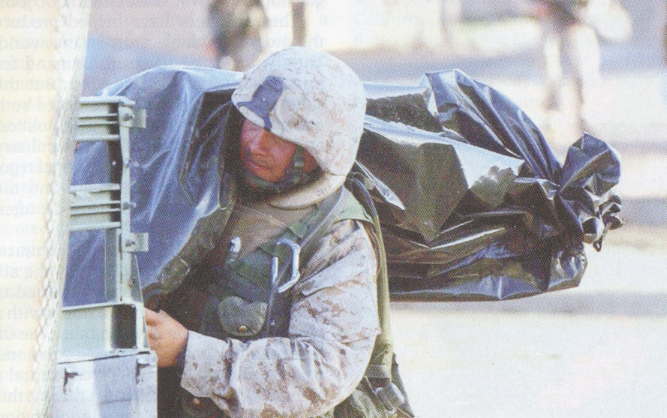 U.S. soldier carrying a body
bag
U.S. soldier carrying a body
bag
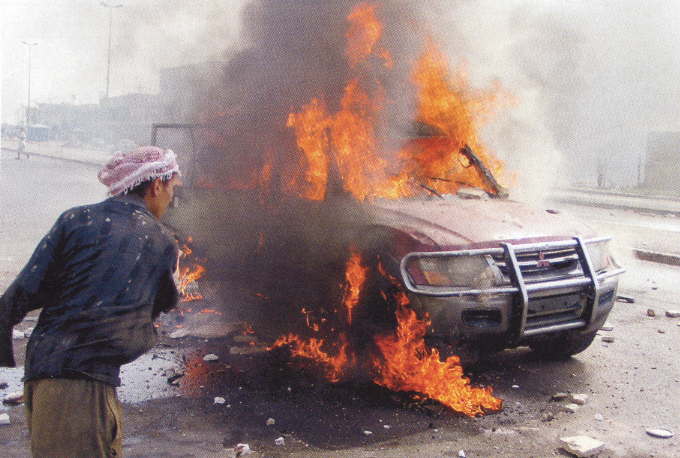 An Iraqi watching a burning
SUV
An Iraqi watching a burning
SUV
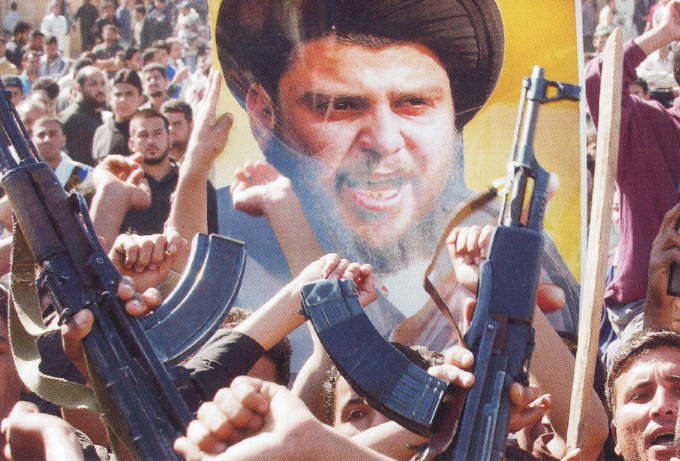 Followers of Muqtada al Sadr
Followers of Muqtada al Sadr

A Muqtada al Sadr supporter
and a burning US army vehicle
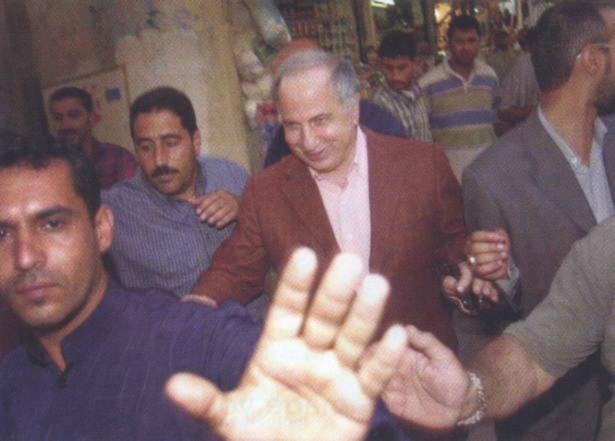
Ahmed Chalabi – who originally
had the ear of the US Department of Defense and supplied
the (false)
info on the build-up of weapons of mass destruction (WMD) in Iraq (and who himself may have been working
for the Iranians)
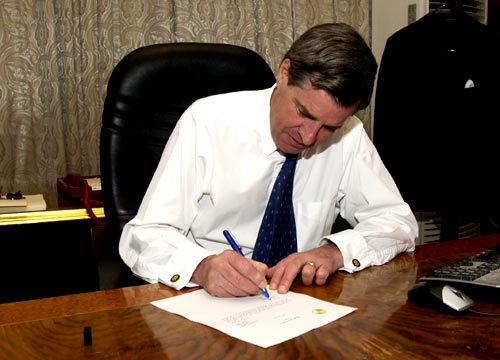
Bremer signing over limited
sovereignty to the appointed Iraqi interim government,
June 28, 2004.
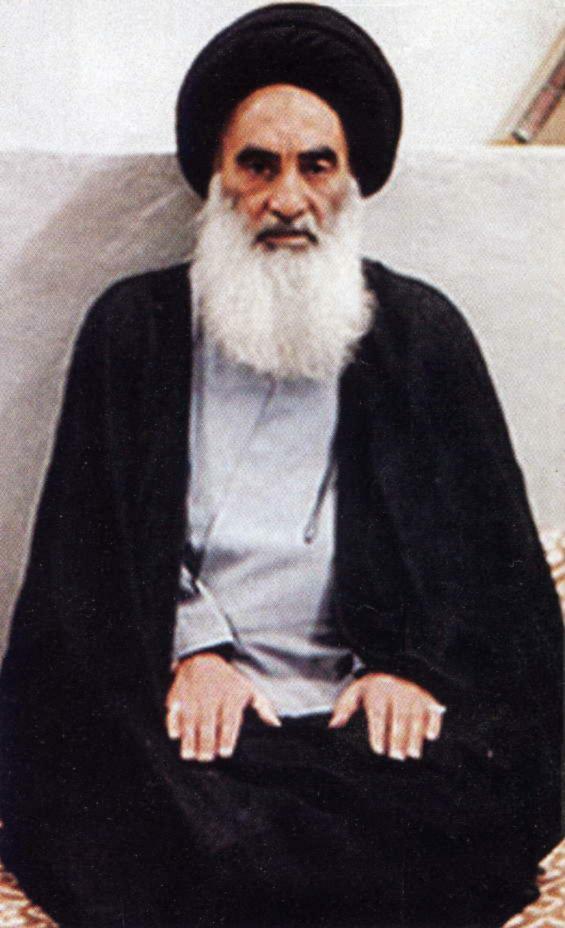
A source of US support in
containing al-Sadr's rebellion is the Iraqi Shi'ite Grand
Ayatollah Ali Husaini Sistani
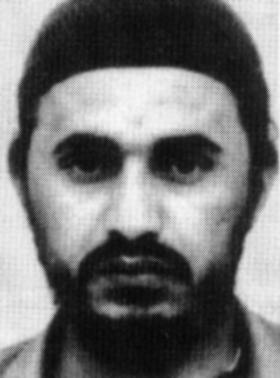
Abu Mussab al-Zarqawi – Jordanian terrorist leader
of "Tawhid and Jihad" in Iraq
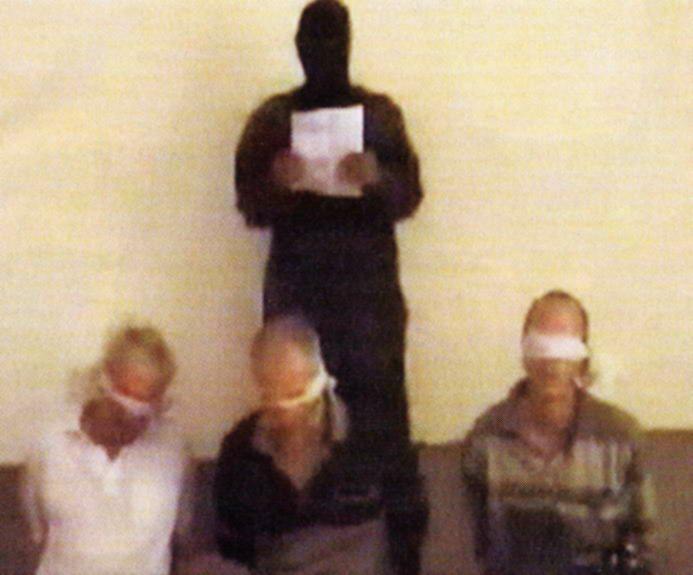
US and British soldiers being
held captive by al Zarqawi (the US troops were beheaded
in front of the camera)
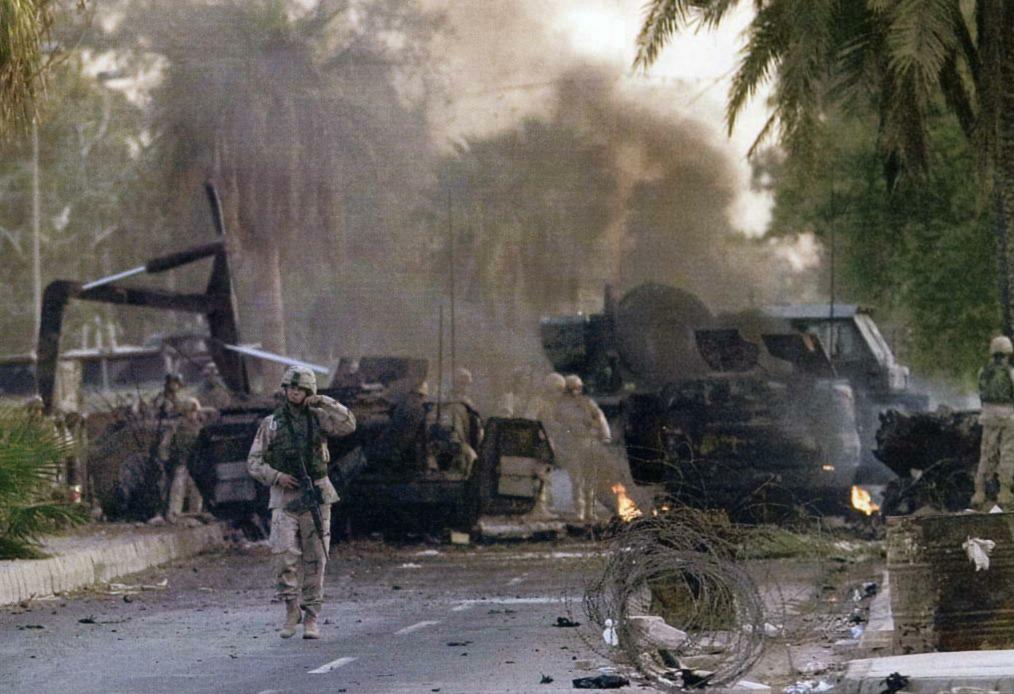
Another car bombing in
Baghdad
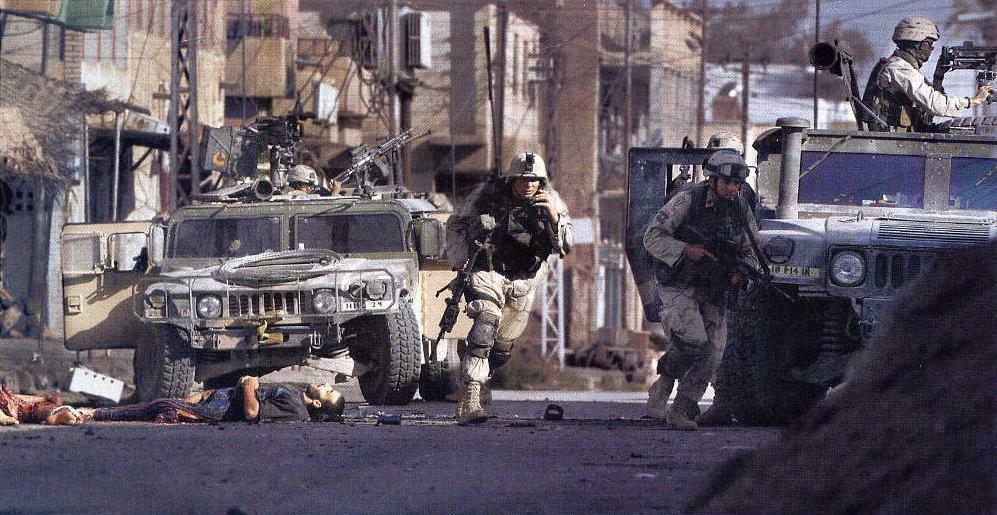
US troops in Samarra sweep
past dead insurgents
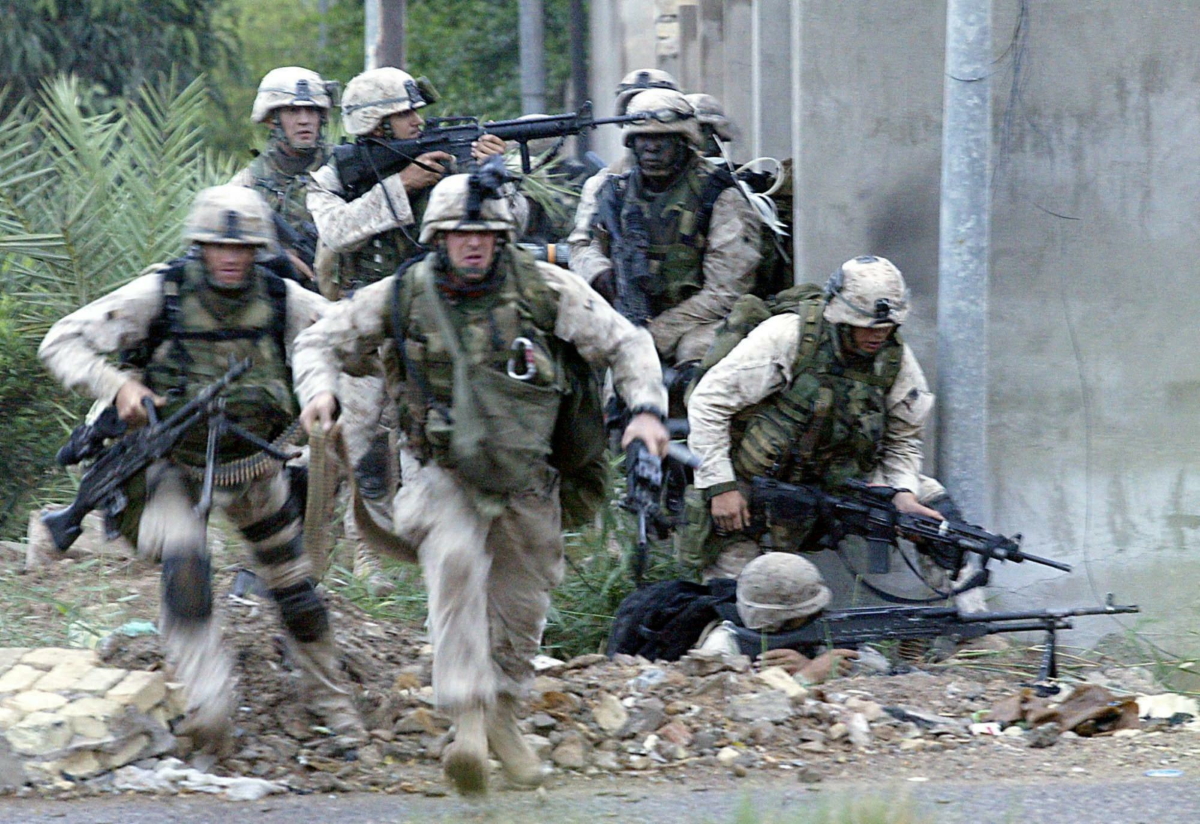
US Marines cross a road in
Fallujah while others provide covering fire during Operation Phantom
Fury / Operation Al Fajr (New Dawn)."
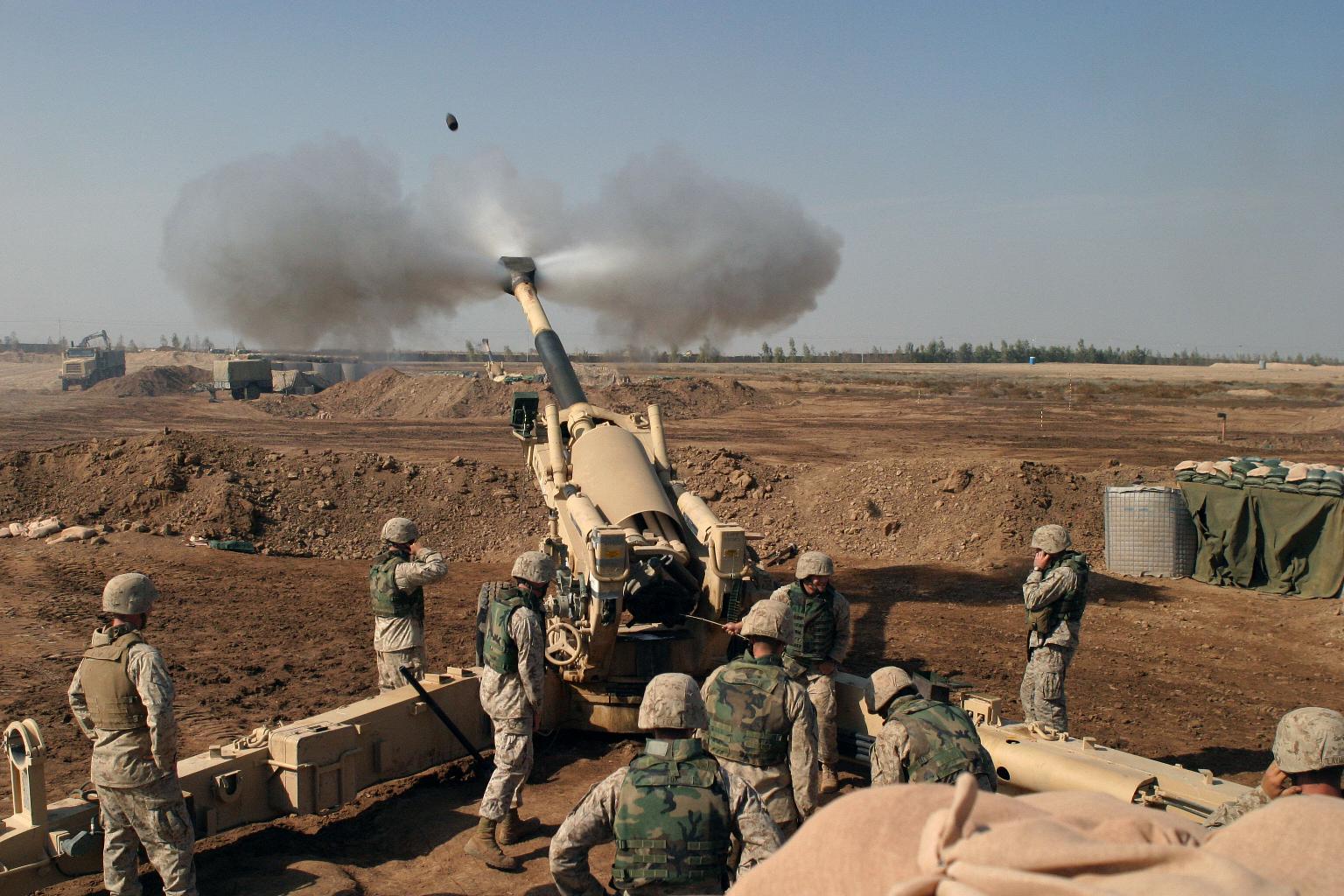
Marines at Camp Fallujah,
Iraq, engage enemy targets in support of Operation Phantom Fury.
Meanwhile "democracy" advanced
... at least in certain parts of the country (mostly the Shi'ite sections)
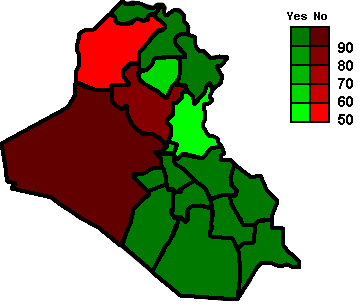
Map of the Iraqi constitution
ratification referendum – October 2005
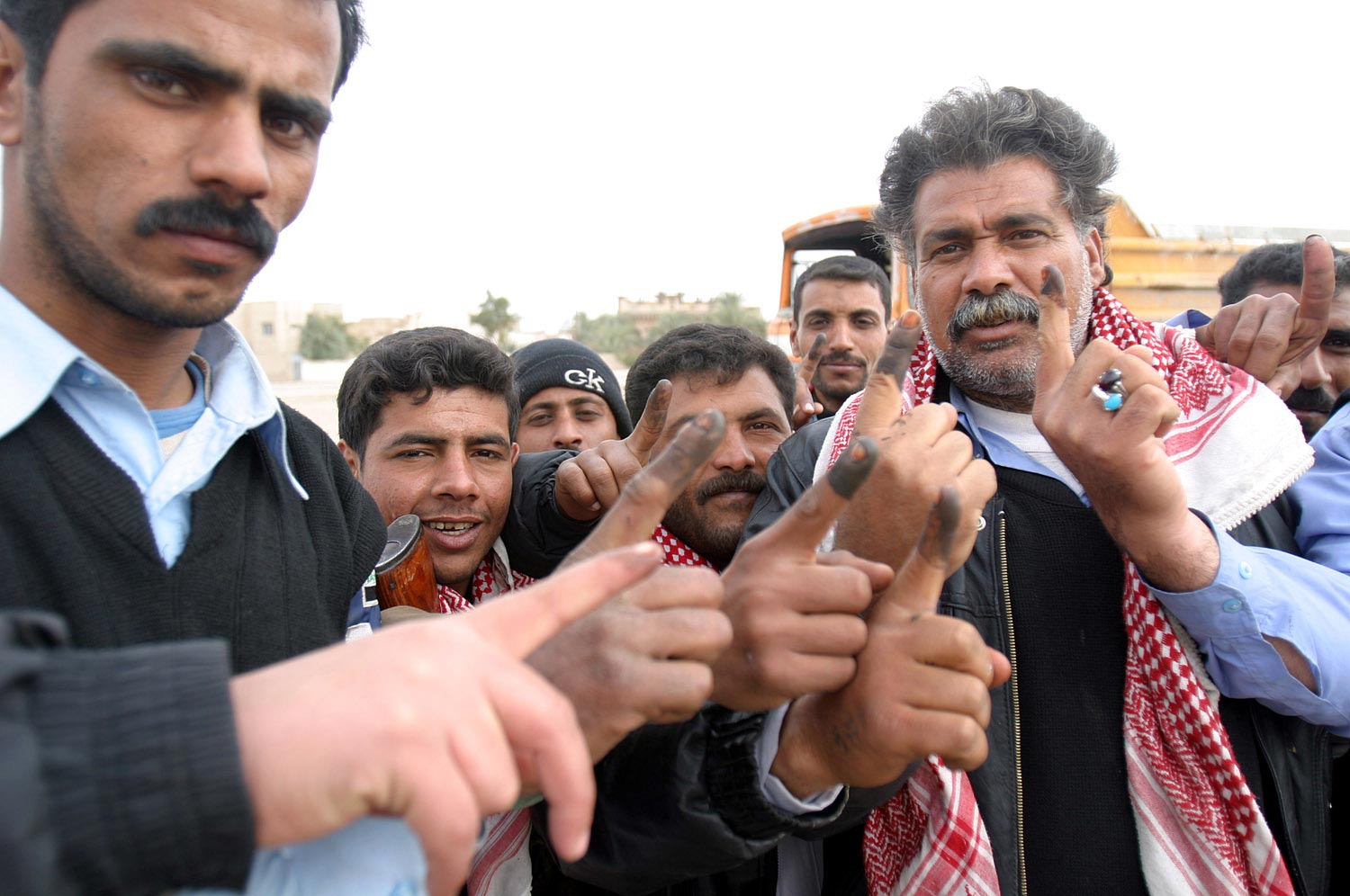
Iraqi voters inked fingers
- December 2005 Iraqi legislative elections
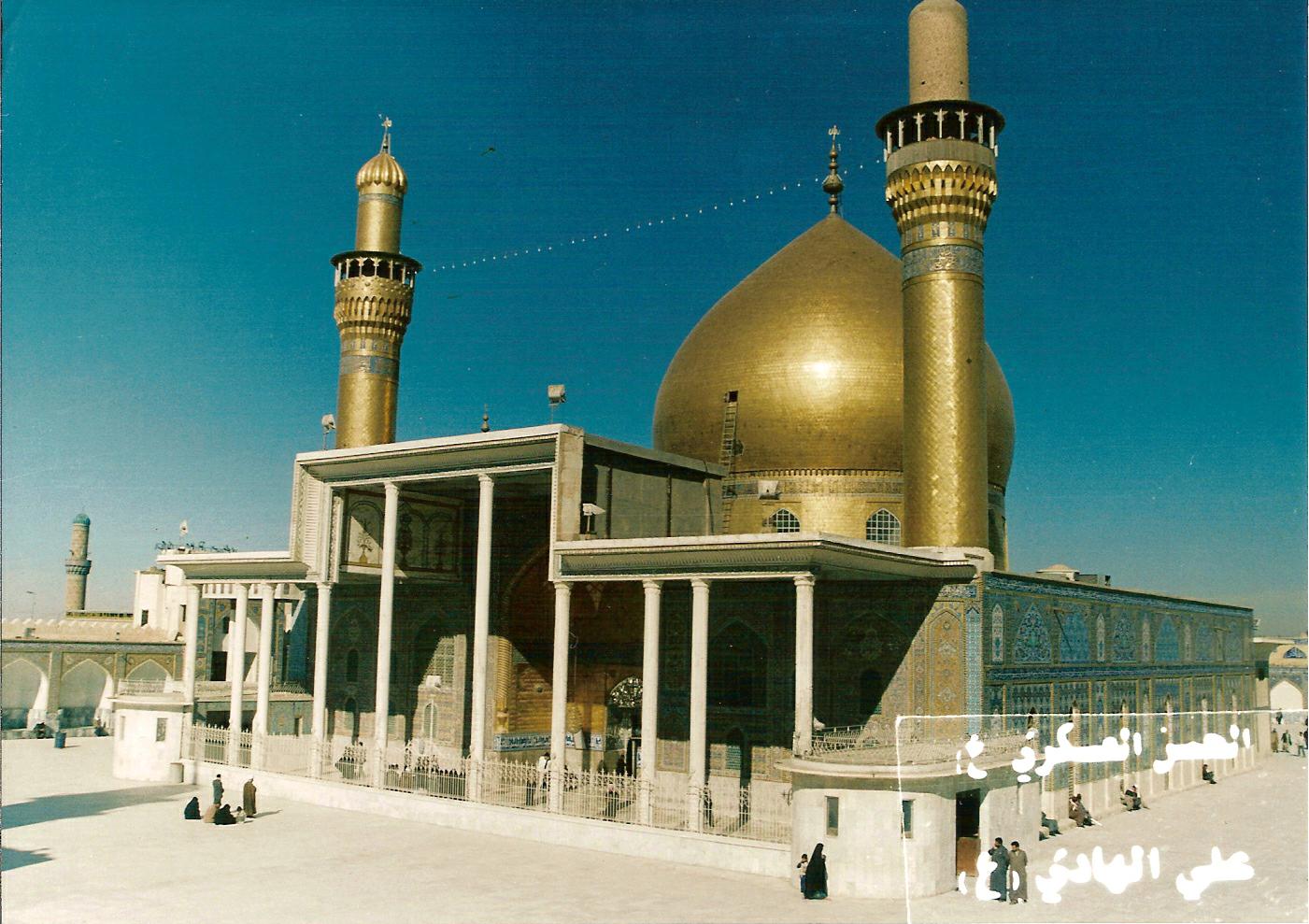
The Al Askari or Golden Dome
Mosque in Samarra – blown up in January 2006 (Shrine of the 10th and 11th Twelver Shi‘a
Imams: Ali an-Naqi and Hasan al-Askari)
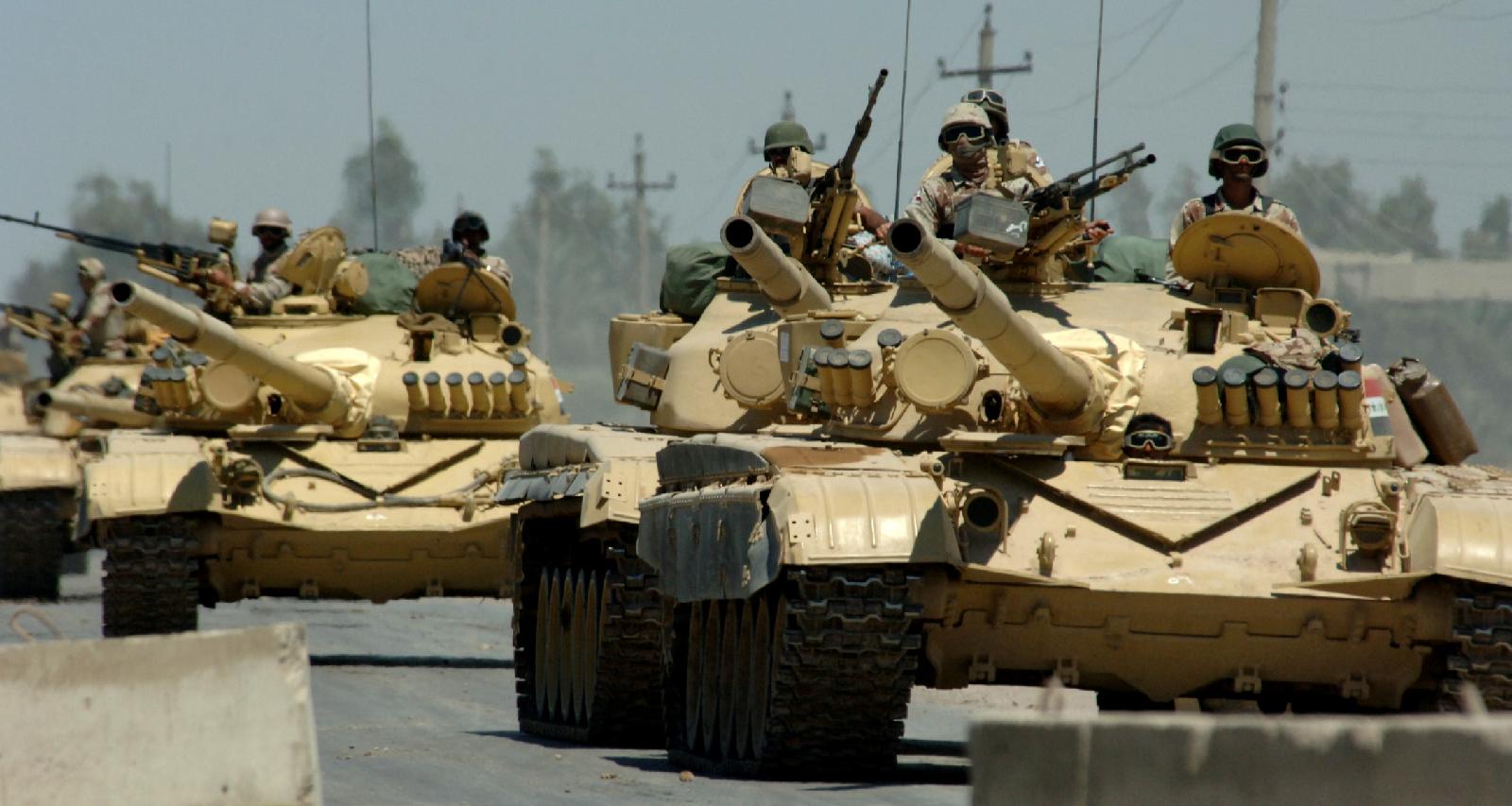
Iraqi Soviet-built T-72 tanks
assigned to the Iraqi Army 9th Mechanized Division
drive through a checkpoint
near Forward Operating Base Camp Taji, Iraq – 18 May 2006.
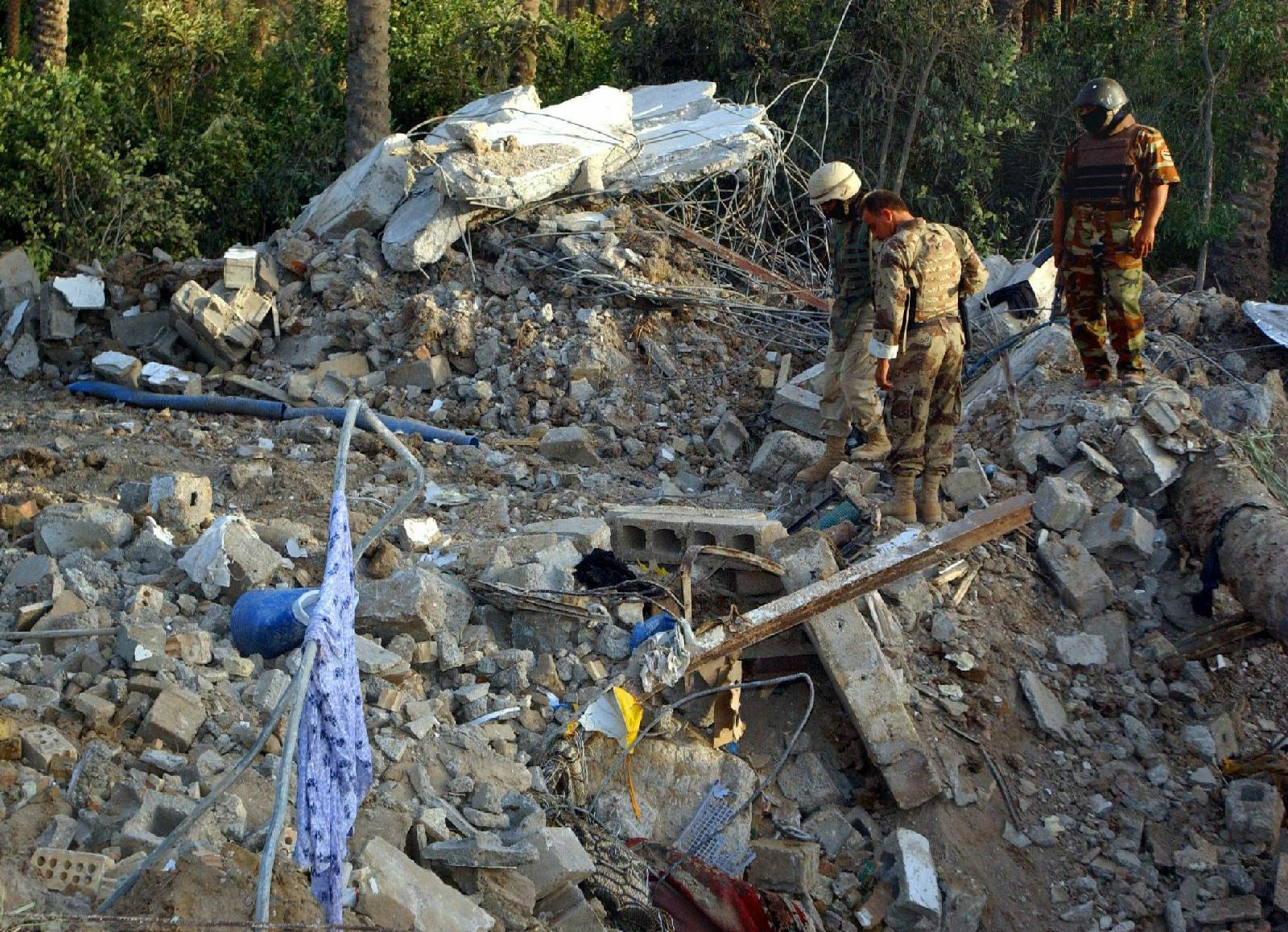
Zarqawi safe house rubble,
June 8 2006
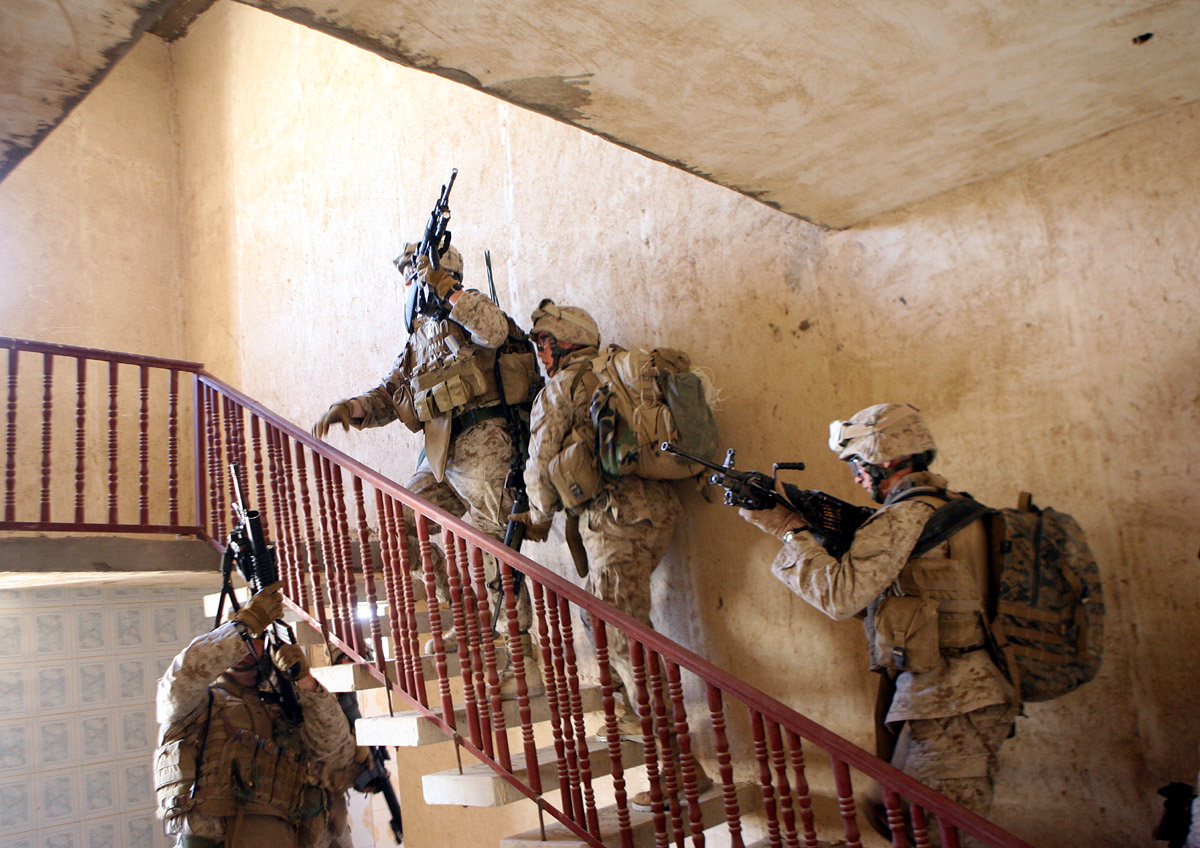
L company 3rd Battalion 3rd
Marines search a house in the Anbar Province – 16 June 2006.
|
Bush realized that continuing to do the same thing
they had been doing since 2003 was a formula for disaster. But how to
move forward? Bush was open for suggestions. His generals were not in
agreement as to what should be done. They were inclined (including
Casey) to view the solution more as a political than a military one.
Morale was not high in the military.
In early December (2006) several study
papers on the Iraq war were brought forward. The one that would
ultimately impress Bush the most was produced by the American
Enterprise Institute – which called for "a large and sustained surge of
U.S. forces to secure and protect critical areas of Baghdad." A
sustained surge would involve the infusion of a substantial number of
new troops. Bush would also reshape the political policy, with more
support for reconstruction, jobs and finally a relaxation of the
anti-Ba'athist policy. This would hopefully also encourage Iraqi Prime
Minister al-Maliki to move his Shi'ite supporters to the center
politically.
Shortly
after the New Year (2007) in a
nationally televised speech, Bush announced that the draw-down of
American troops would cease for the time being – and in fact 20,000
troops would be added to the number already in Iraq, most of them
embedded within Iraqi units. These new troops would be part of a new
surge strategy that would allow Iraqis and Americans to retake Iraq
from the insurgents – and this time hold it while Iraqi forces
continued to be built up to take full responsibility. One by one towns
that had fallen to insurgents would be retaken and held. Later that
month in his State of the Union address Bush repeated the details of
his policy change in Iraq. He also made some key personnel changes,
bringing Casey to the White House as Army Chief of Staff and Gen. David
Petraeus to replace him as American commander in Iraq.
But the surge announcement upset
politicians both in Iraq and within Congress. By a slight majority, the
Iraqi parliament demanded a timetable for withdrawal of American and
British troops. But interestingly at this point al-Sadr announced his
decision to be cooperative. Meanwhile, Democrats in Congress were
outraged. Kennedy, Reid, Biden, and Pelosi all supported a non-binding
resolution going on record as disapproving the surge strategy.
Nonetheless, Bush got Congressional
authorization financing the surge – but also a warning from Republicans
that there had better be signs very soon of the improvement of things
in Iraq or he would begin losing additional Republican support in
Congress.
Then in July the Senate passed a bill
(largely along party lines) requiring all American troops to be out of
Iraq by the following April (2008); but the bill did not have enough
votes to override a presidential veto. Nonetheless it was a clear sign
of the loss of American support for the war in Iraq.
But apparently the surge had been working! Toward the end of the year
(2007) there was clearly a large reduction in the level of violence in
Iraq. The British were ready to hand over the strategic province of
Basra to local authorities. And Bush indicated that a withdrawal of
American troops could begin soon. Indeed, in the last months of his
presidency he began the withdrawing of troops (8,000) from Iraq.
|
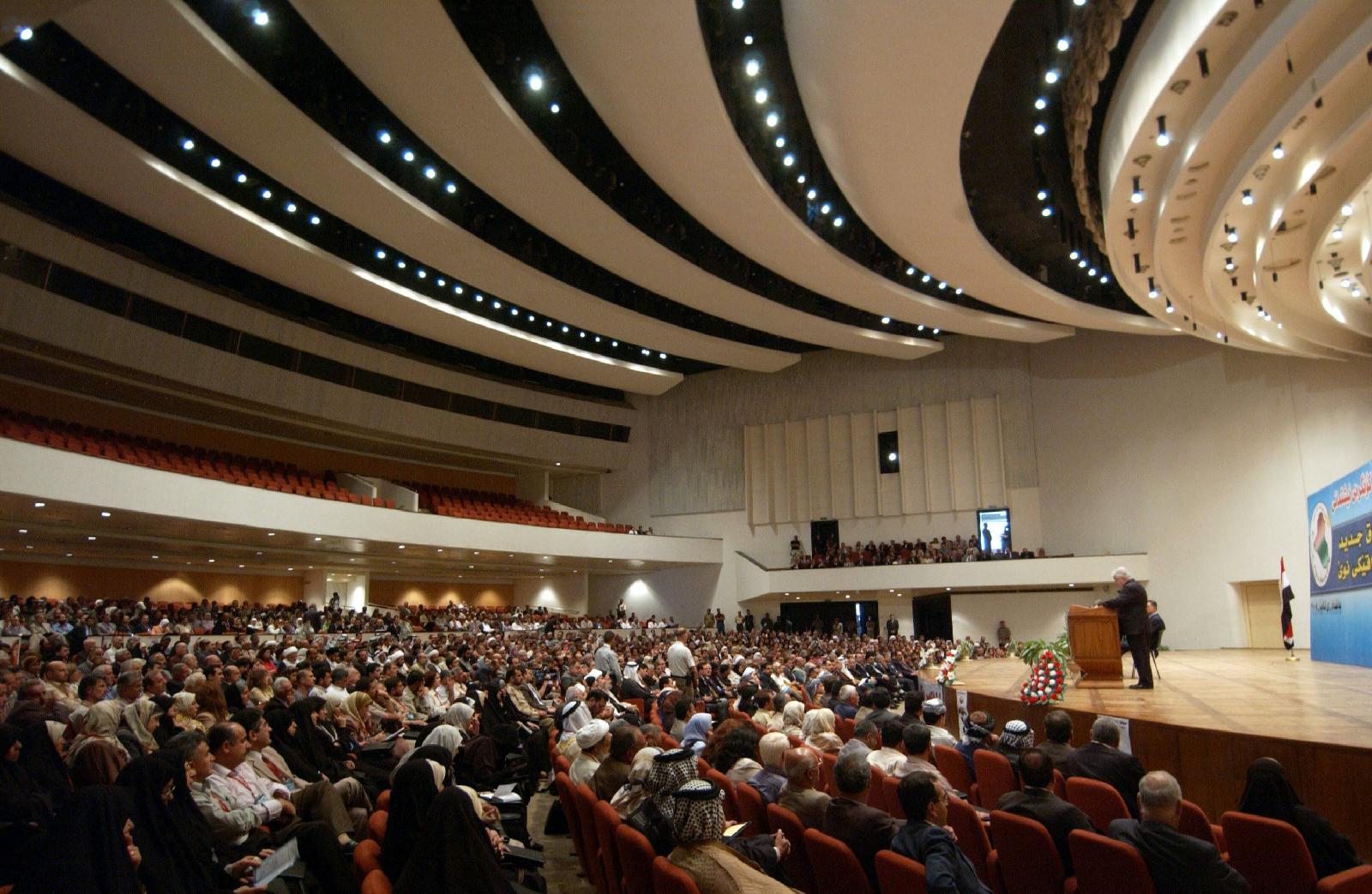
Inside of the Baghdad
Convention Center, where the Council of Representatives of Iraq meets.
This photo shows delegates
from all over Iraq convening for the Iraqi National Conference – 30 December
2008.

Go on to the next section: The Bush Economy
 Miles
H. Hodges Miles
H. Hodges
| | |


 The idea of extending the "Bush
The idea of extending the "Bush Bush decides that it is time for Saddam
Bush decides that it is time for Saddam Things begin to bog down for the U.S. in
Things begin to bog down for the U.S. in 2004: The situation in Iraq worsens
2004: The situation in Iraq worsens
 The 2004 presidential election
The 2004 presidential election
 The Iraqi "quagmire" deepens
The Iraqi "quagmire" deepens







































































